Form 8-K VALERO ENERGY CORP/TX For: Mar 27
UNITED STATES
SECURITIES AND EXCHANGE COMMISSION
Washington, D.C. 20549
FORM 8-K
CURRENT REPORT
Pursuant to Section 13 or 15(d)
of the Securities Exchange Act of 1934
Date of Report (Date of earliest event reported): March 27, 2017
VALERO ENERGY CORPORATION
(Exact name of registrant as specified in its charter)
| Delaware | 1-13175 | 74-1828067 | ||
| (State or other jurisdiction of incorporation) |
(Commission File Number) |
(IRS Employer Identification No.) | ||
| One Valero Way San Antonio, Texas |
78249 | |||
| (Address of principal executive offices) | (Zip Code) | |||
Registrant’s telephone number, including area code: (210) 345-2000
Check the appropriate box below if the Form 8-K filing is intended to simultaneously satisfy the filing obligation of the registrant under any of the following provisions (see General Instruction A.2. below):
| ☐ | Written communications pursuant to Rule 425 under the Securities Act (17 CFR 230.425) |
| ☐ | Soliciting material pursuant to Rule 14a-12 under the Exchange Act (17 CFR 240.14a-12) |
| ☐ | Pre-commencement communications pursuant to Rule 14d-2(b) under the Exchange Act (17 CFR 240.14d-2(b)) |
| ☐ | Pre-commencement communications pursuant to Rule 13e-4(c) under the Exchange Act (17 CFR 240.13e-4(c)) |
| Item 7.01 | Regulation FD Disclosure. |
Senior management of Valero Energy Corporation (the “Company”) is updating the Company’s investor presentation. The slides attached to this report were prepared for management’s presentations. The slides are included in Exhibit 99.01 to this report and are incorporated herein by reference. The slides will be available on the Company’s website at www.valero.com.
The information in this report is being furnished, not filed, pursuant to Regulation FD. Accordingly, the information in Items 7.01 and 9.01 of this report will not be incorporated by reference into any registration statement filed by the Company under the Securities Act of 1933, as amended, unless specifically identified therein as being incorporated therein by reference. The furnishing of the information in this report is not intended to, and does not, constitute a determination or admission by the Company that the information in this report is material or complete, or that investors should consider this information before making an investment decision with respect to any security of the Company or any of its affiliates.
Safe Harbor Statement
Statements contained in the exhibit to this report that state the Company’s or its management’s expectations or predictions of the future are forward-looking statements intended to be covered by the safe harbor provisions of the Securities Act of 1933, as amended, and the Securities Exchange Act of 1934, as amended. It is important to note that the Company’s actual results could differ materially from those projected in such forward-looking statements. Factors that could affect those results include those mentioned in the documents that the Company has filed with the Securities and Exchange Commission.
| Item 9.01 | Financial Statements and Exhibits. |
| (d) | Exhibits. |
99.01 Slides from management presentation.
2
SIGNATURE
Pursuant to the requirements of the Securities Exchange Act of 1934, the Company has duly caused this report to be signed on its behalf by the undersigned hereunto duly authorized.
| VALERO ENERGY CORPORATION | ||||||
| Date: March 27, 2017 | by: | /s/ Jay D. Browning | ||||
| Jay D. Browning | ||||||
| Executive Vice President and General Counsel | ||||||
3
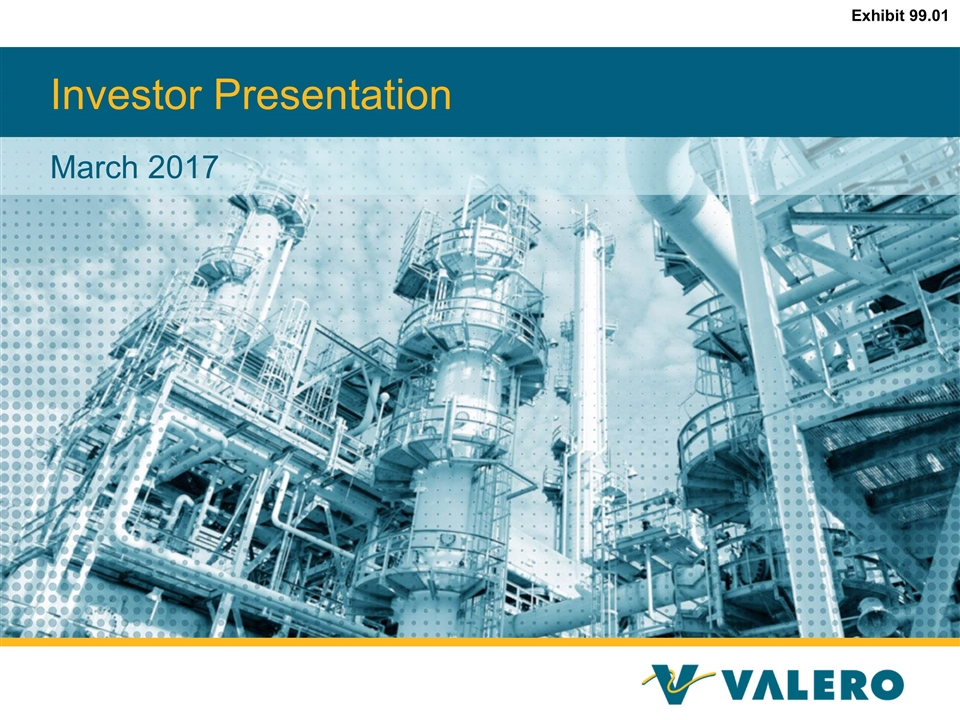
Investor Presentation March 2017 Exhibit 99.01
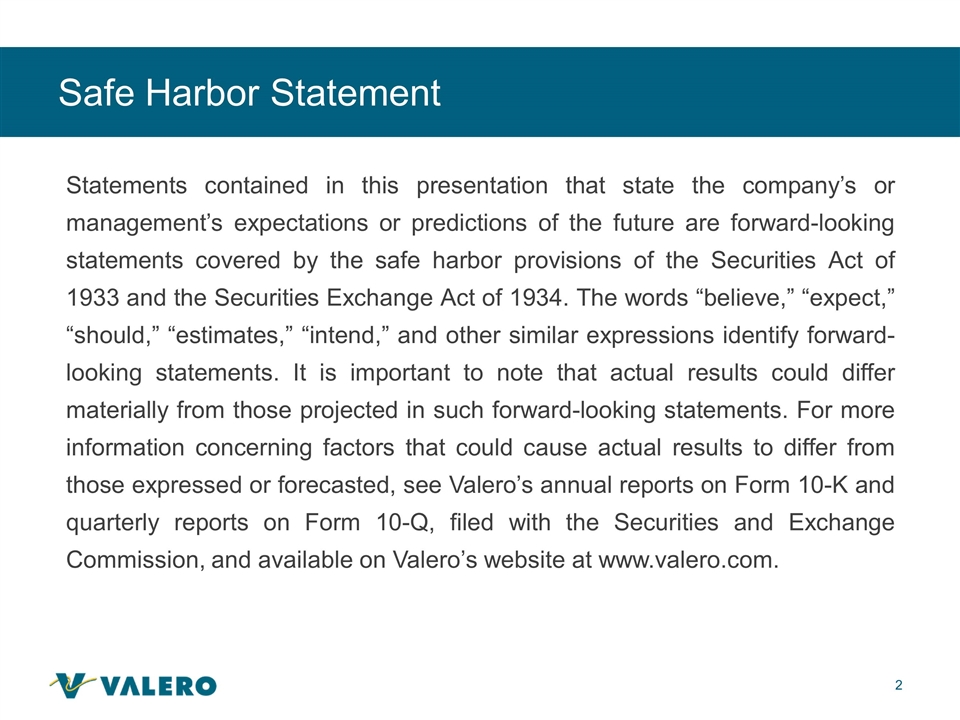
Safe Harbor Statement Statements contained in this presentation that state the company’s or management’s expectations or predictions of the future are forward-looking statements covered by the safe harbor provisions of the Securities Act of 1933 and the Securities Exchange Act of 1934. The words “believe,” “expect,” “should,” “estimates,” “intend,” and other similar expressions identify forward-looking statements. It is important to note that actual results could differ materially from those projected in such forward-looking statements. For more information concerning factors that could cause actual results to differ from those expressed or forecasted, see Valero’s annual reports on Form 10-K and quarterly reports on Form 10-Q, filed with the Securities and Exchange Commission, and available on Valero’s website at www.valero.com.
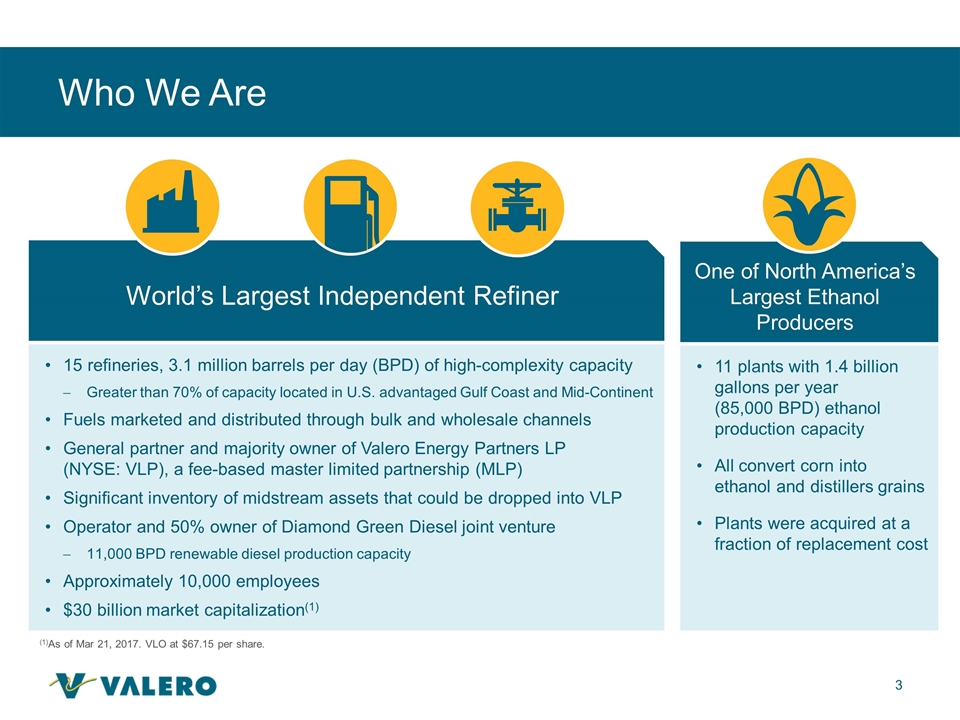
Who We Are World’s Largest Independent Refiner 15 refineries, 3.1 million barrels per day (BPD) of high-complexity capacity Greater than 70% of capacity located in U.S. advantaged Gulf Coast and Mid-Continent Fuels marketed and distributed through bulk and wholesale channels General partner and majority owner of Valero Energy Partners LP (NYSE: VLP), a fee-based master limited partnership (MLP) Significant inventory of midstream assets that could be dropped into VLP Operator and 50% owner of Diamond Green Diesel joint venture 11,000 BPD renewable diesel production capacity Approximately 10,000 employees $30 billion market capitalization(1) One of North America’s Largest Ethanol Producers 11 plants with 1.4 billion gallons per year (85,000 BPD) ethanol production capacity All convert corn into ethanol and distillers grains Plants were acquired at a fraction of replacement cost (1)As of Mar 21, 2017. VLO at $67.15 per share.

Strong Presence in Advantaged U.S. Gulf Coast and Mid-Continent Refineries and ethanol plants are in advantaged locations See slide 23 for capacities.
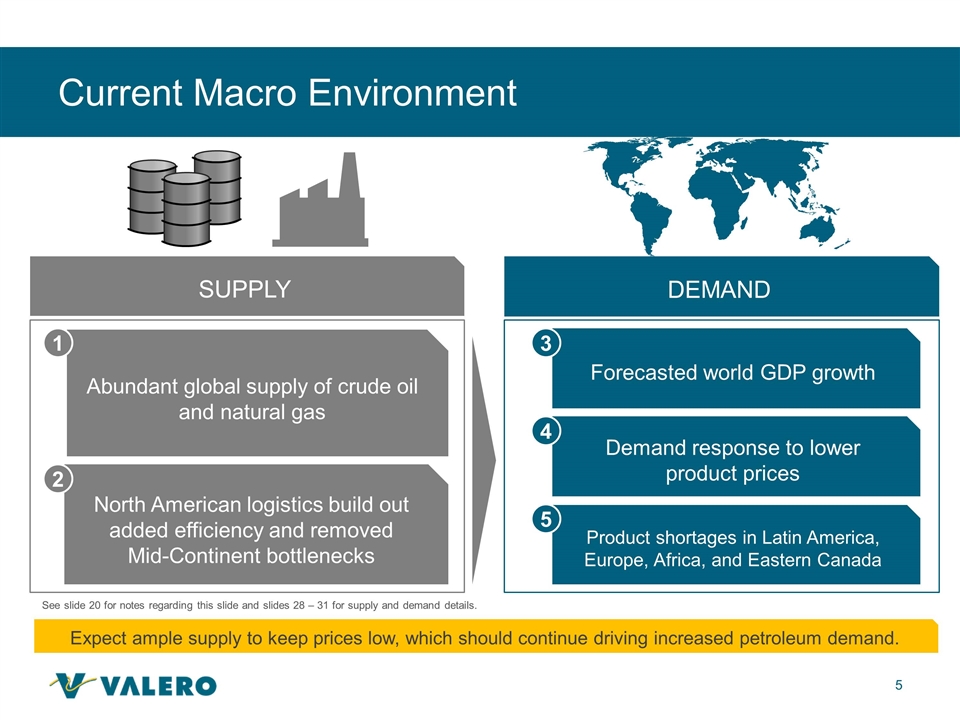
Current Macro Environment Abundant global supply of crude oil and natural gas Forecasted world GDP growth Product shortages in Latin America, Europe, Africa, and Eastern Canada Demand response to lower product prices SUPPLY DEMAND North American logistics build out added efficiency and removed Mid-Continent bottlenecks 2 See slide 20 for notes regarding this slide and slides 28 – 31 for supply and demand details. Expect ample supply to keep prices low, which should continue driving increased petroleum demand. 1 3 4 5
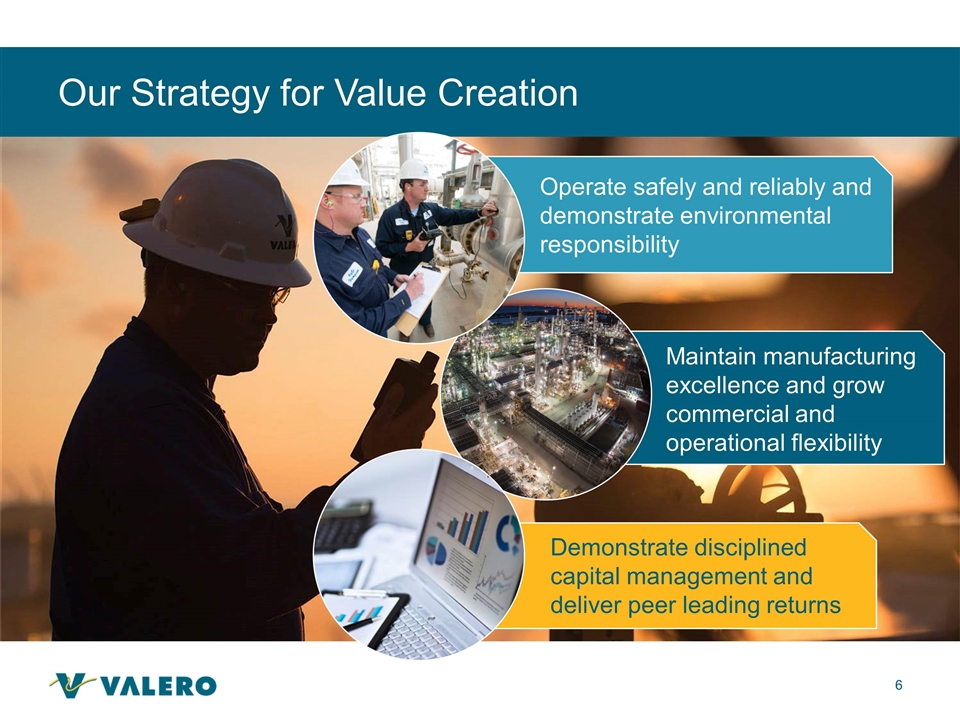
Maintain manufacturing excellence and grow commercial and operational flexibility Our Strategy for Value Creation Operate safely and reliably and demonstrate environmental responsibility Demonstrate disciplined capital management and deliver peer leading returns
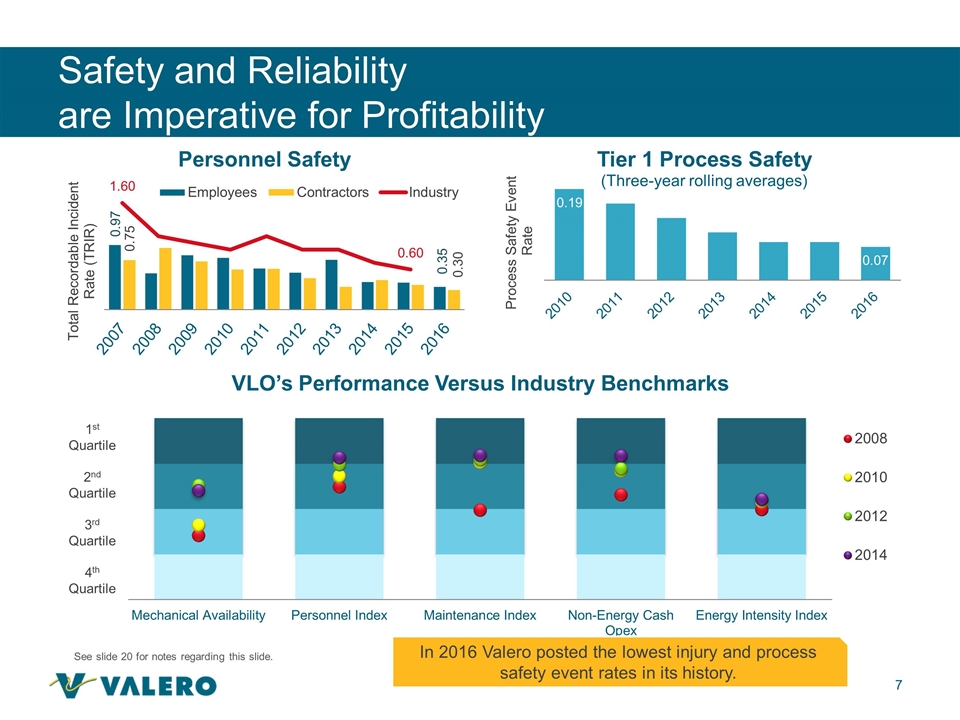
Safety and Reliability are Imperative for Profitability See slide 20 for notes regarding this slide. In 2016 Valero posted the lowest injury and process safety event rates in its history.
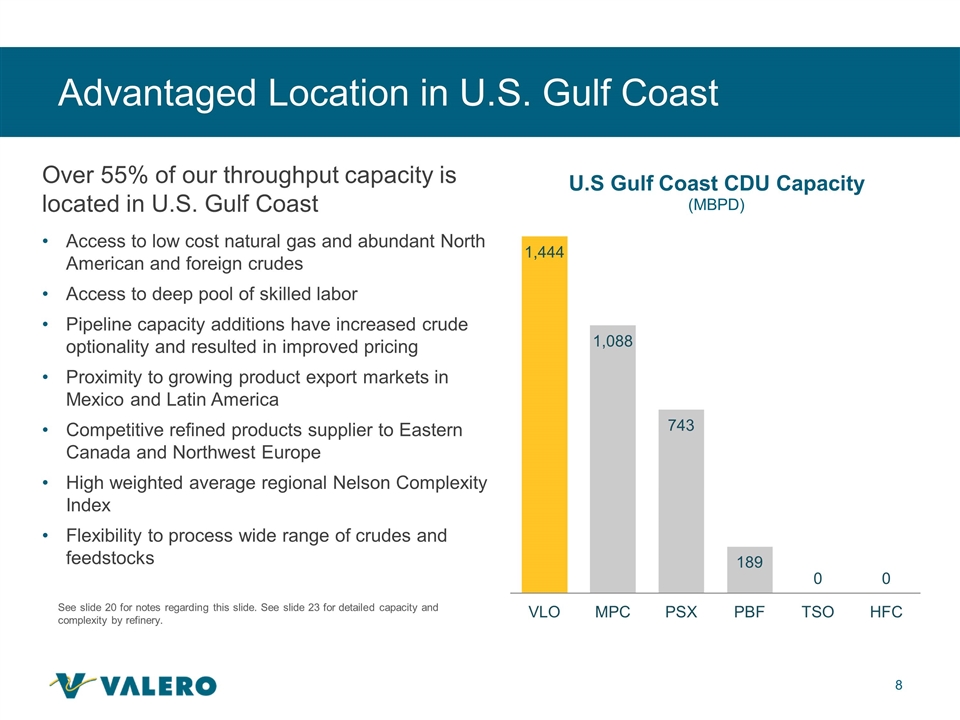
Advantaged Location in U.S. Gulf Coast See slide 20 for notes regarding this slide. See slide 23 for detailed capacity and complexity by refinery. Over 55% of our throughput capacity is located in U.S. Gulf Coast Access to low cost natural gas and abundant North American and foreign crudes Access to deep pool of skilled labor Pipeline capacity additions have increased crude optionality and resulted in improved pricing Proximity to growing product export markets in Mexico and Latin America Competitive refined products supplier to Eastern Canada and Northwest Europe High weighted average regional Nelson Complexity Index Flexibility to process wide range of crudes and feedstocks
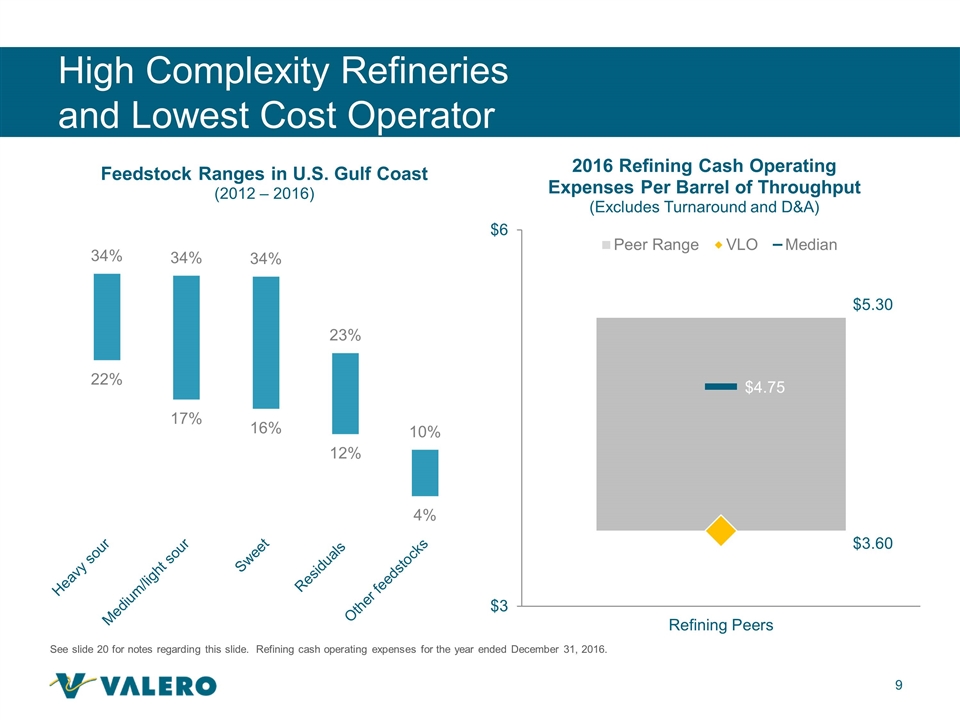
High Complexity Refineries and Lowest Cost Operator See slide 20 for notes regarding this slide. Refining cash operating expenses for the year ended December 31, 2016.
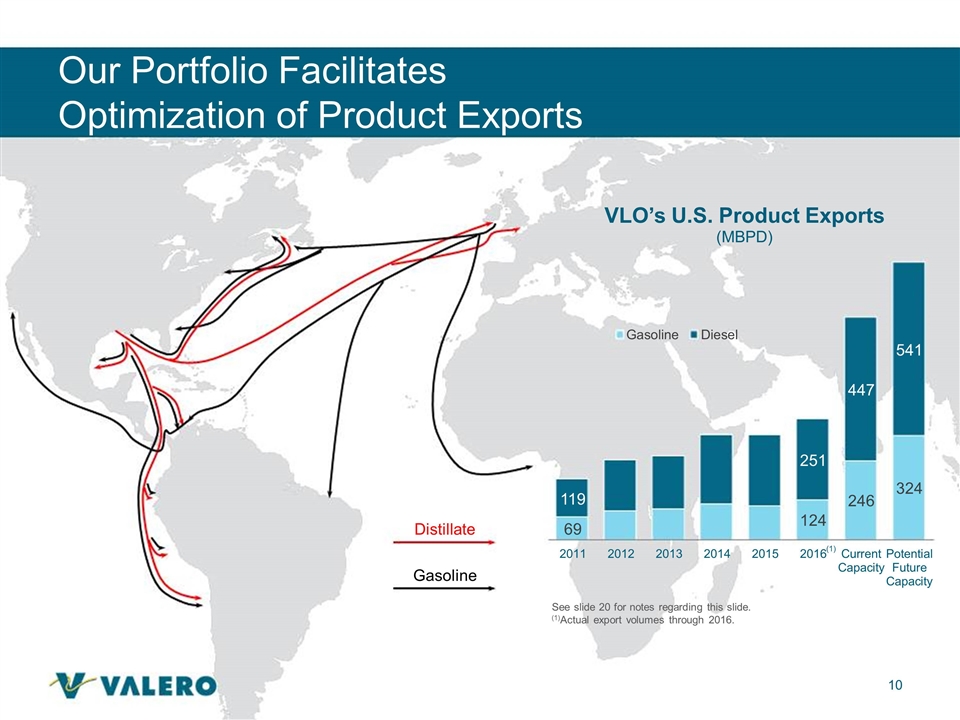
Our Portfolio Facilitates Optimization of Product Exports Distillate Gasoline See slide 20 for notes regarding this slide. (1)Actual export volumes through 2016. (1)
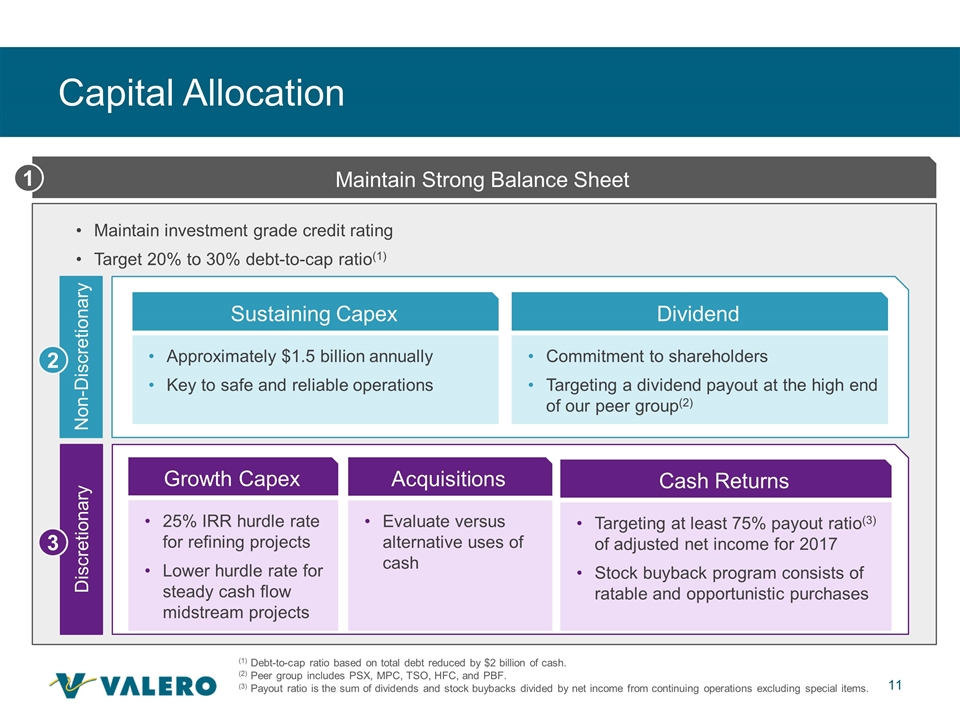
Capital Allocation Maintain Strong Balance Sheet (1)Debt-to-cap ratio based on total debt reduced by $2 billion of cash. (2)Peer group includes PSX, MPC, TSO, HFC, and PBF. (3)Payout ratio is the sum of dividends and stock buybacks divided by net income from continuing operations excluding special items. Sustaining Capex Approximately $1.5 billion annually Key to safe and reliable operations Dividend Commitment to shareholders Targeting a dividend payout at the high end of our peer group(2) Non-Discretionary Growth Capex 25% IRR hurdle rate for refining projects Lower hurdle rate for steady cash flow midstream projects Cash Returns Targeting at least 75% payout ratio(3) of adjusted net income for 2017 Stock buyback program consists of ratable and opportunistic purchases Acquisitions Evaluate versus alternative uses of cash Discretionary Maintain investment grade credit rating Target 20% to 30% debt-to-cap ratio(1) 1 2 3
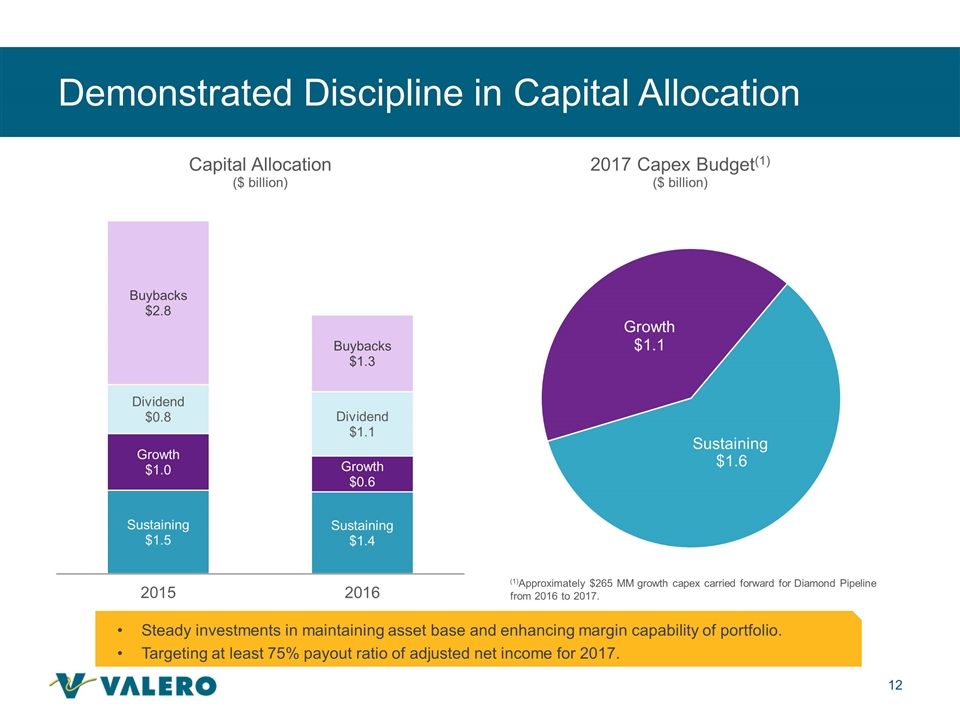
Demonstrated Discipline in Capital Allocation Steady investments in maintaining asset base and enhancing margin capability of portfolio. Targeting at least 75% payout ratio of adjusted net income for 2017. (1)Approximately $265 MM growth capex carried forward for Diamond Pipeline from 2016 to 2017. Sustaining
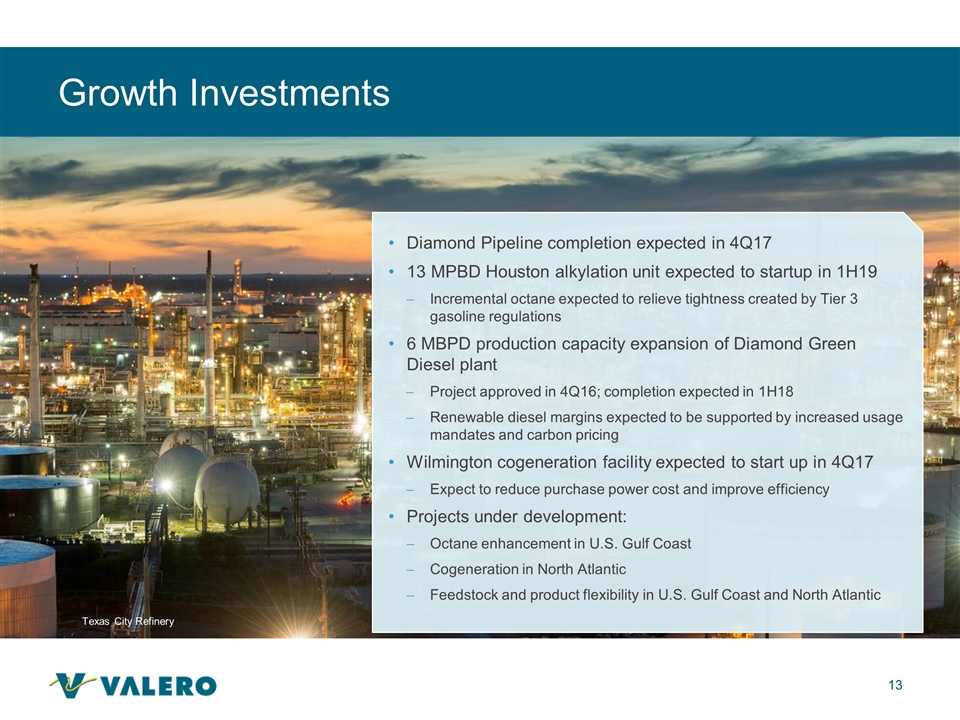
Growth Investments Diamond Pipeline completion expected in 4Q17 13 MPBD Houston alkylation unit expected to startup in 1H19 Incremental octane expected to relieve tightness created by Tier 3 gasoline regulations 6 MBPD production capacity expansion of Diamond Green Diesel plant Project approved in 4Q16; completion expected in 1H18 Renewable diesel margins expected to be supported by increased usage mandates and carbon pricing Wilmington cogeneration facility expected to start up in 4Q17 Expect to reduce purchase power cost and improve efficiency Projects under development: Octane enhancement in U.S. Gulf Coast Cogeneration in North Atlantic Feedstock and product flexibility in U.S. Gulf Coast and North Atlantic Texas City Refinery

Outperformed Peers in Total Stockholder Return for Two Years Ended 2016 Peer group includes PSX, MPC, TSO, HFC, and PBF. See slide 20 for notes regarding this slide. Total stockholder return (TSR) from Dec 31, 2014, through Dec 30, 2016. TSR year to date 2017 as of Mar 21, 2017. Since end of 2014, current leadership team has delivered consistent outperformance. Second highest TSR in peer group for 2016 stand alone. Highest TSR year to date 2017 VLO +48% Peer average+21% Peer minimum-6%

Grow VLP primarily through drop downs from VLO Target organic growth opportunities and midstream deals strategic to VLO’s core business or that provide third party revenue Grow annual distributions at target rates of 25% through 2017 and at least 20% for 2018 Maintain investment grade credit rating Our Sponsored MLP Valero Energy Partners LP (NYSE:VLP) Strategy See slide 20 for notes regarding this slide and slides 34 – 37 for VLP non-GAAP disclosures. * This is the minimum quarterly distribution (MQD). The actual distribution was smaller as it was prorated for the period of December 16 – 31. (1) Annualized using 4Q16 EBITDA. 91% increase in quarterly cash distribution over MQD Grew annualized EBITDA attributable to the Partnership to more than $300 million(1) 4.25 million common unit follow-on equity offering completed in Nov 2015 ATM program established in Sep 2016 Completed $500 million debt offering in Dec 2016 Financial Highlights
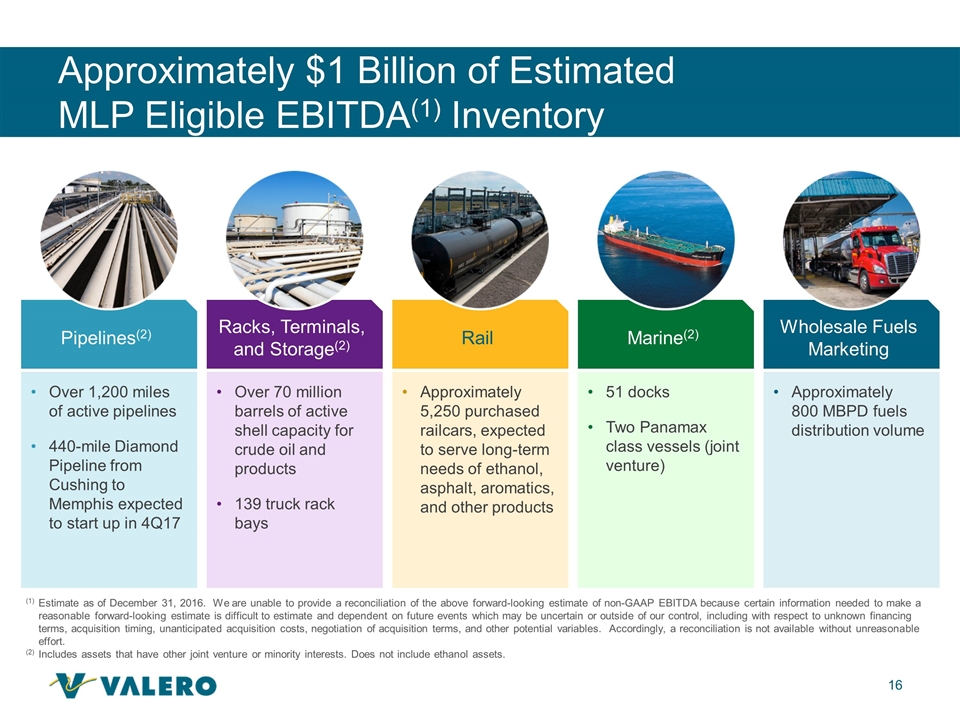
Approximately $1 Billion of Estimated MLP Eligible EBITDA(1) Inventory Racks, Terminals, and Storage(2) Over 70 million barrels of active shell capacity for crude oil and products 139 truck rack bays Rail Approximately 5,250 purchased railcars, expected to serve long-term needs of ethanol, asphalt, aromatics, and other products Pipelines(2) Over 1,200 miles of active pipelines 440-mile Diamond Pipeline from Cushing to Memphis expected to start up in 4Q17 Marine(2) 51 docks Two Panamax class vessels (joint venture) (1)Estimate as of December 31, 2016. We are unable to provide a reconciliation of the above forward-looking estimate of non-GAAP EBITDA because certain information needed to make a reasonable forward-looking estimate is difficult to estimate and dependent on future events which may be uncertain or outside of our control, including with respect to unknown financing terms, acquisition timing, unanticipated acquisition costs, negotiation of acquisition terms, and other potential variables. Accordingly, a reconciliation is not available without unreasonable effort. (2) Includes assets that have other joint venture or minority interests. Does not include ethanol assets. Wholesale Fuels Marketing Approximately 800 MBPD fuels distribution volume
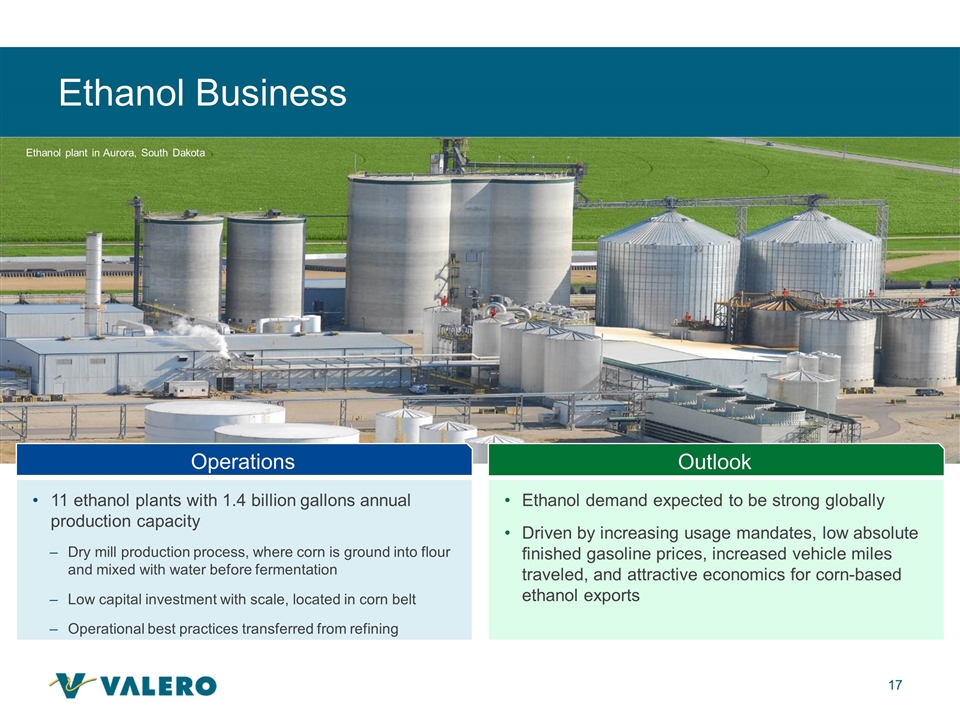
Ethanol Business Operations 11 ethanol plants with 1.4 billion gallons annual production capacity Dry mill production process, where corn is ground into flour and mixed with water before fermentation Low capital investment with scale, located in corn belt Operational best practices transferred from refining Outlook Ethanol demand expected to be strong globally Driven by increasing usage mandates, low absolute finished gasoline prices, increased vehicle miles traveled, and attractive economics for corn-based ethanol exports Ethanol plant in Aurora, South Dakota
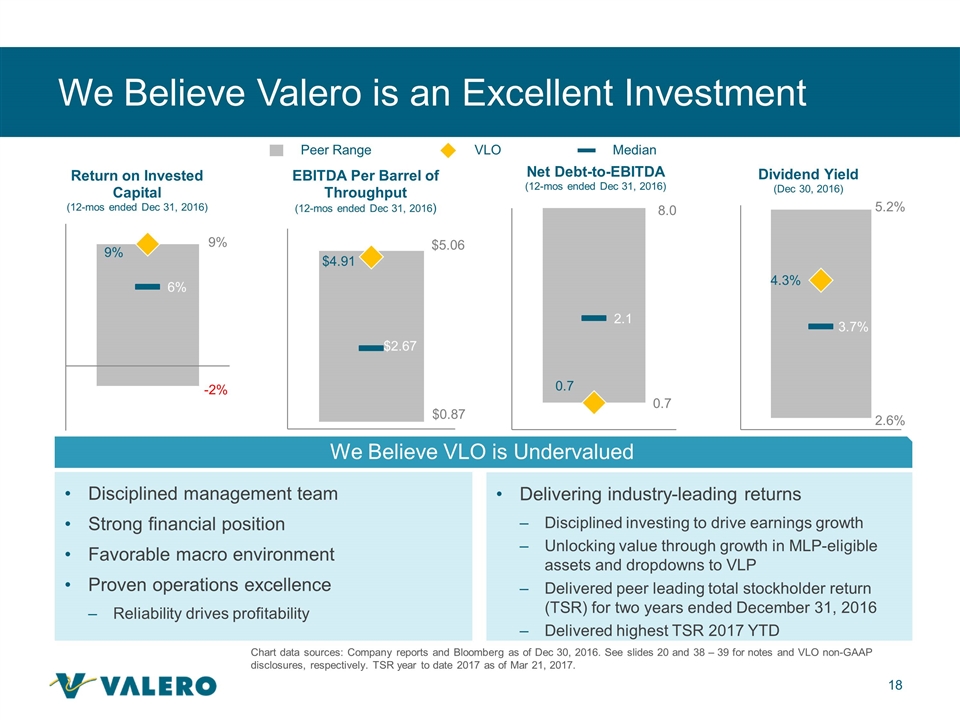
We Believe Valero is an Excellent Investment Chart data sources: Company reports and Bloomberg as of Dec 30, 2016. See slides 20 and 38 – 39 for notes and VLO non-GAAP disclosures, respectively. TSR year to date 2017 as of Mar 21, 2017. We Believe VLO is Undervalued Disciplined management team Strong financial position Favorable macro environment Proven operations excellence Reliability drives profitability Delivering industry-leading returns Disciplined investing to drive earnings growth Unlocking value through growth in MLP-eligible assets and dropdowns to VLP Delivered peer leading total stockholder return (TSR) for two years ended December 31, 2016 Delivered highest TSR 2017 YTD Peer RangeVLOMedian 8.0
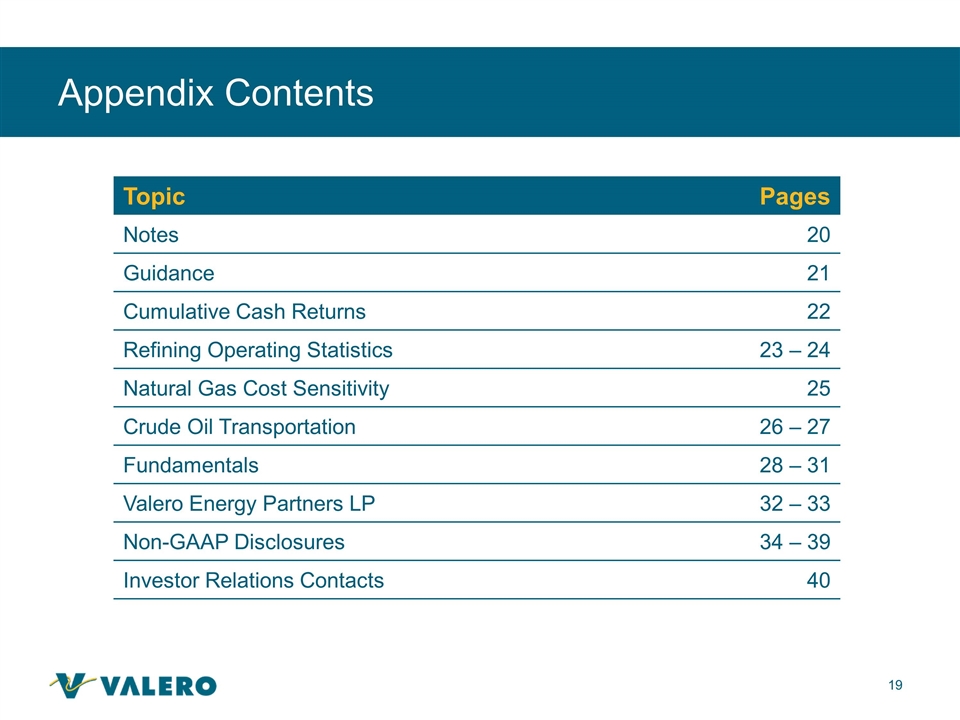
Appendix Contents Topic Pages Notes 20 Guidance 21 Cumulative Cash Returns 22 Refining Operating Statistics 23 – 24 Natural Gas Cost Sensitivity 25 Crude Oil Transportation 26 – 27 Fundamentals 28 – 31 Valero Energy Partners LP 32 – 33 Non-GAAP Disclosures 34 – 39 Investor Relations Contacts 40
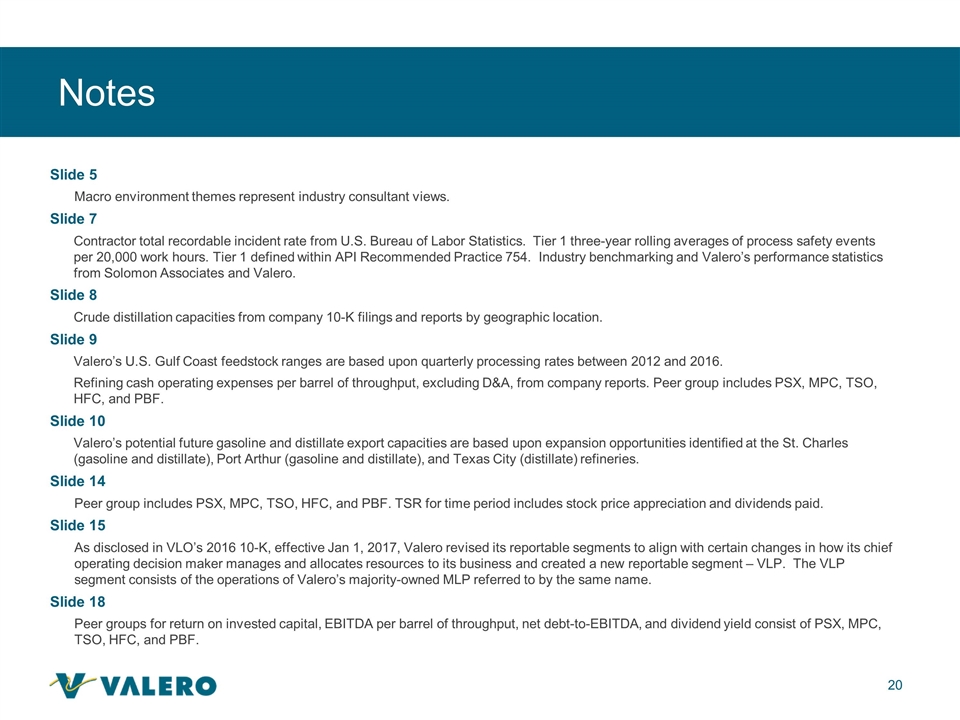
Notes Slide 5 Macro environment themes represent industry consultant views. Slide 7 Contractor total recordable incident rate from U.S. Bureau of Labor Statistics. Tier 1 three-year rolling averages of process safety events per 20,000 work hours. Tier 1 defined within API Recommended Practice 754. Industry benchmarking and Valero’s performance statistics from Solomon Associates and Valero. Slide 8 Crude distillation capacities from company 10-K filings and reports by geographic location. Slide 9 Valero’s U.S. Gulf Coast feedstock ranges are based upon quarterly processing rates between 2012 and 2016. Refining cash operating expenses per barrel of throughput, excluding D&A, from company reports. Peer group includes PSX, MPC, TSO, HFC, and PBF. Slide 10 Valero’s potential future gasoline and distillate export capacities are based upon expansion opportunities identified at the St. Charles (gasoline and distillate), Port Arthur (gasoline and distillate), and Texas City (distillate) refineries. Slide 14 Peer group includes PSX, MPC, TSO, HFC, and PBF. TSR for time period includes stock price appreciation and dividends paid. Slide 15 As disclosed in VLO’s 2016 10-K, effective Jan 1, 2017, Valero revised its reportable segments to align with certain changes in how its chief operating decision maker manages and allocates resources to its business and created a new reportable segment – VLP. The VLP segment consists of the operations of Valero’s majority-owned MLP referred to by the same name. Slide 18 Peer groups for return on invested capital, EBITDA per barrel of throughput, net debt-to-EBITDA, and dividend yield consist of PSX, MPC, TSO, HFC, and PBF.
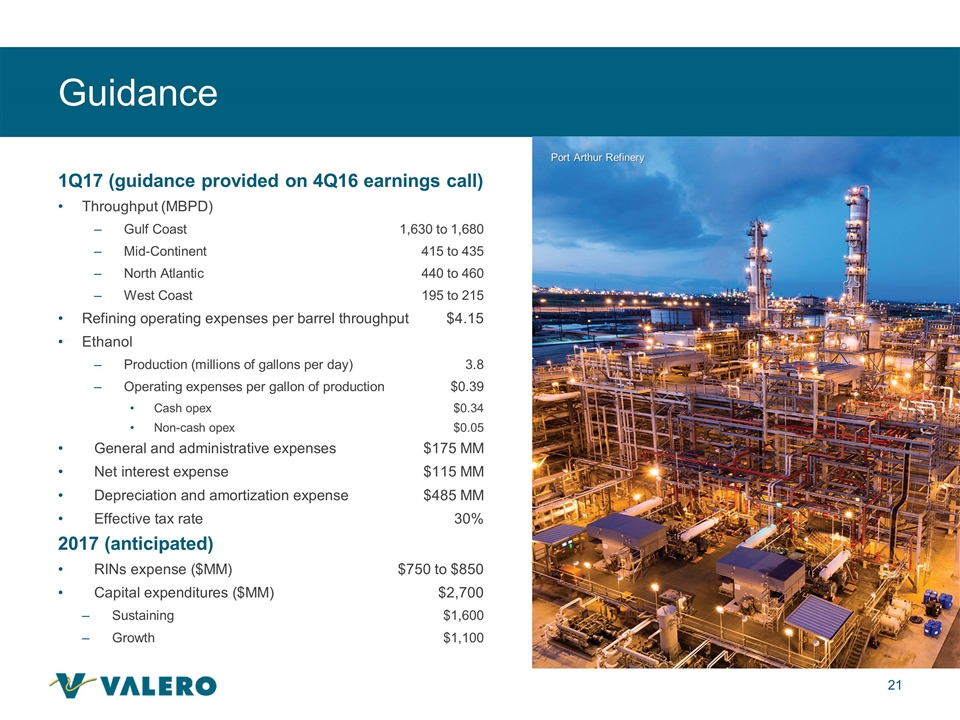
Guidance 1Q17 (guidance provided on 4Q16 earnings call) Throughput (MBPD) Gulf Coast1,630 to 1,680 Mid-Continent415 to 435 North Atlantic440 to 460 West Coast195 to 215 Refining operating expenses per barrel throughput$4.15 Ethanol Production (millions of gallons per day)3.8 Operating expenses per gallon of production$0.39 Cash opex$0.34 Non-cash opex$0.05 General and administrative expenses$175 MM Net interest expense$115 MM Depreciation and amortization expense$485 MM Effective tax rate30% 2017 (anticipated) RINs expense ($MM)$750 to $850 Capital expenditures ($MM) $2,700 Sustaining$1,600 Growth$1,100 Port Arthur Refinery
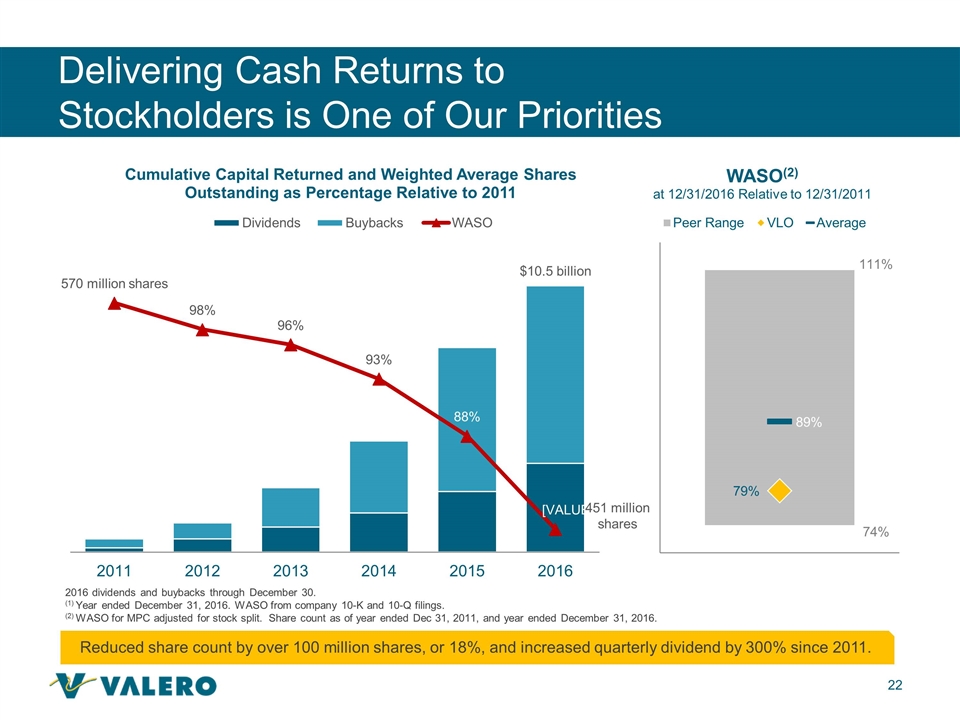
Delivering Cash Returns to Stockholders is One of Our Priorities 2016 dividends and buybacks through December 30. (1) Year ended December 31, 2016. WASO from company 10-K and 10-Q filings. (2) WASO for MPC adjusted for stock split. Share count as of year ended Dec 31, 2011, and year ended December 31, 2016. $10.5 billion Reduced share count by over 100 million shares, or 18%, and increased quarterly dividend by 300% since 2011. 451 million shares
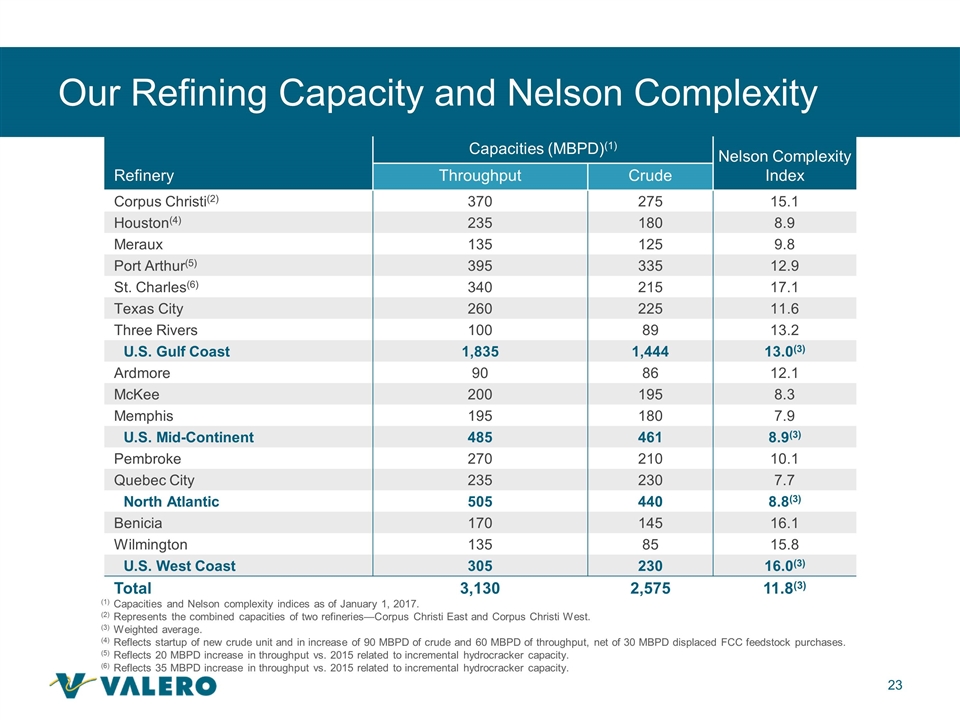
Our Refining Capacity and Nelson Complexity Refinery Capacities (MBPD)(1) Nelson Complexity Index Throughput Crude Corpus Christi(2) 370 275 15.1 Houston(4) 235 180 8.9 Meraux 135 125 9.8 Port Arthur(5) 395 335 12.9 St. Charles(6) 340 215 17.1 Texas City 260 225 11.6 Three Rivers 100 89 13.2 U.S. Gulf Coast 1,835 1,444 13.0(3) Ardmore 90 86 12.1 McKee 200 195 8.3 Memphis 195 180 7.9 U.S. Mid-Continent 485 461 8.9(3) Pembroke 270 210 10.1 Quebec City 235 230 7.7 North Atlantic 505 440 8.8(3) Benicia 170 145 16.1 Wilmington 135 85 15.8 U.S. West Coast 305 230 16.0(3) Total 3,130 2,575 11.8(3) (1)Capacities and Nelson complexity indices as of January 1, 2017. (2)Represents the combined capacities of two refineries—Corpus Christi East and Corpus Christi West. (3)Weighted average. (4) Reflects startup of new crude unit and in increase of 90 MBPD of crude and 60 MBPD of throughput, net of 30 MBPD displaced FCC feedstock purchases. (5)Reflects 20 MBPD increase in throughput vs. 2015 related to incremental hydrocracker capacity. (6) Reflects 35 MBPD increase in throughput vs. 2015 related to incremental hydrocracker capacity.
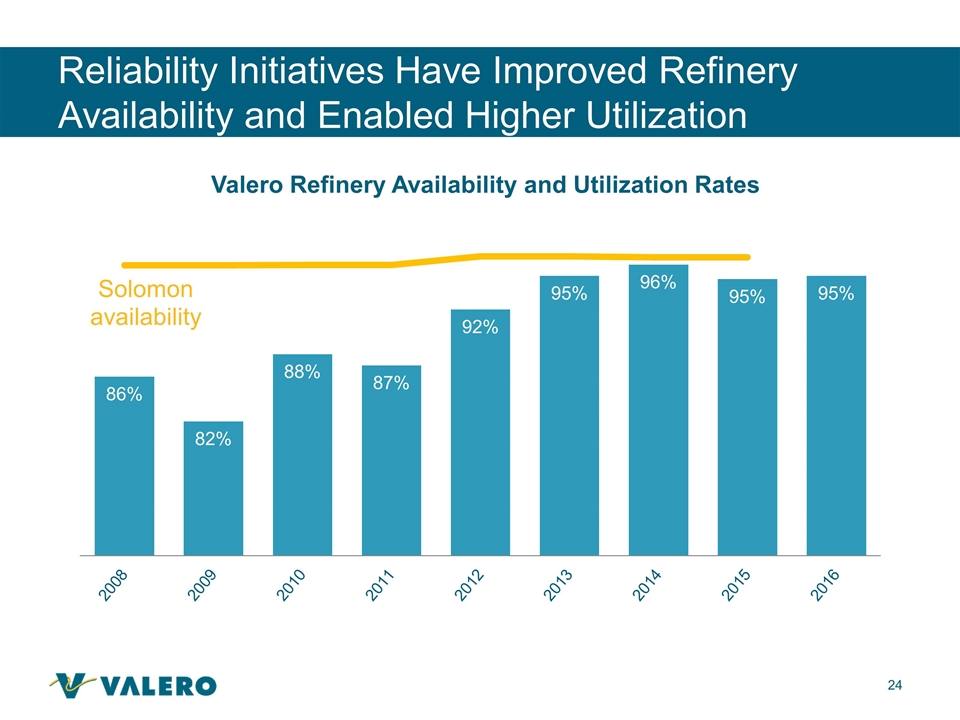
Reliability Initiatives Have Improved Refinery Availability and Enabled Higher Utilization
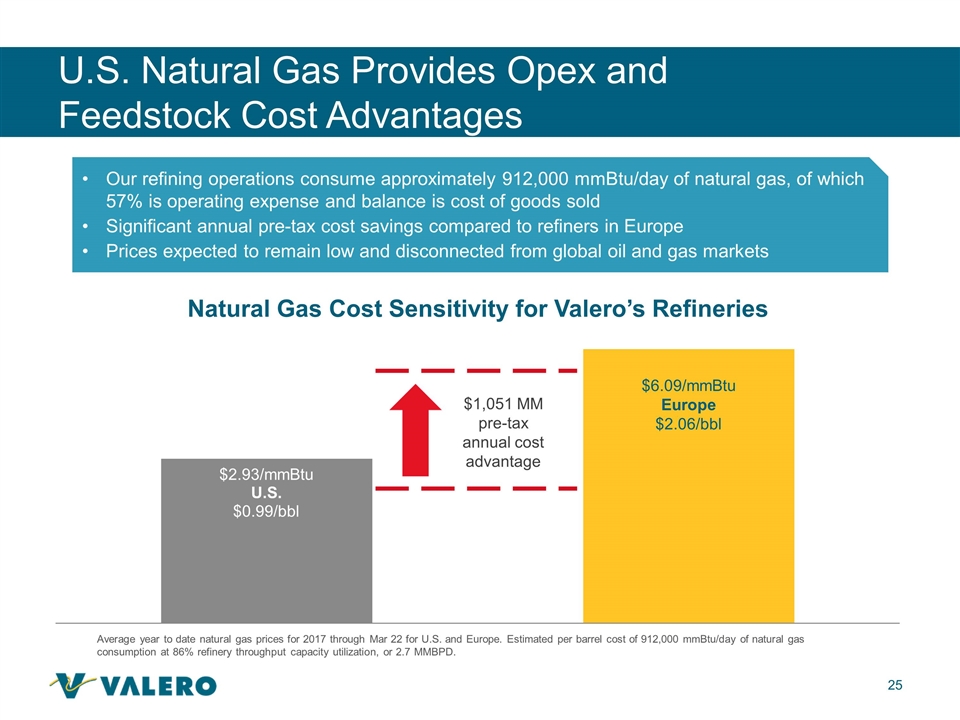
U.S. Natural Gas Provides Opex and Feedstock Cost Advantages Average year to date natural gas prices for 2017 through Mar 22 for U.S. and Europe. Estimated per barrel cost of 912,000 mmBtu/day of natural gas consumption at 86% refinery throughput capacity utilization, or 2.7 MMBPD. $1,051 MM pre-tax annual cost advantage Our refining operations consume approximately 912,000 mmBtu/day of natural gas, of which 57% is operating expense and balance is cost of goods sold Significant annual pre-tax cost savings compared to refiners in Europe Prices expected to remain low and disconnected from global oil and gas markets $6.09/mmBtu Europe $2.06/bbl
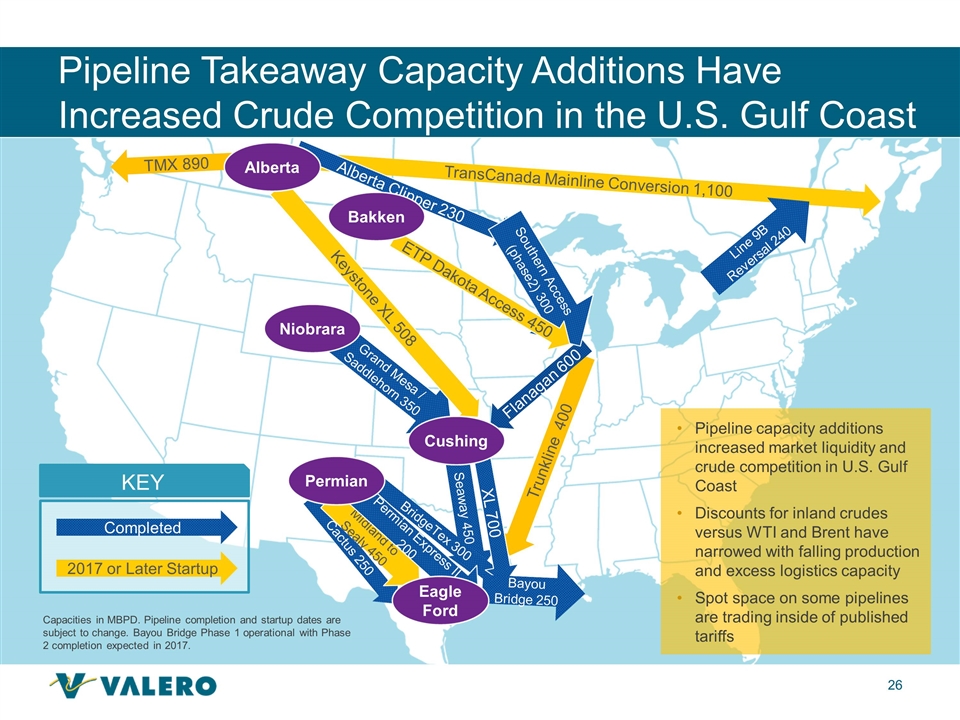
Trunkline 400 Flanagan 600 Pipeline Takeaway Capacity Additions Have Increased Crude Competition in the U.S. Gulf Coast TransCanada Mainline Conversion 1,100 TMX 890 Grand Mesa / Saddlehorn 350 Niobrara Seaway 450 KEY Completed 2017 or Later Startup Capacities in MBPD. Pipeline completion and startup dates are subject to change. Bayou Bridge Phase 1 operational with Phase 2 completion expected in 2017. Line 9B Reversal 240 Cactus 250 BridgeTex 300 XL 700 Cushing Alberta Clipper 230 Midland to Sealy 450 Permian Express II 200 Permian Pipeline capacity additions increased market liquidity and crude competition in U.S. Gulf Coast Discounts for inland crudes versus WTI and Brent have narrowed with falling production and excess logistics capacity Spot space on some pipelines are trading inside of published tariffs Bayou Bridge 250 Eagle Ford Southern Access (phase2) 300 ETP Dakota Access 450 Bakken Keystone XL 508 Alberta
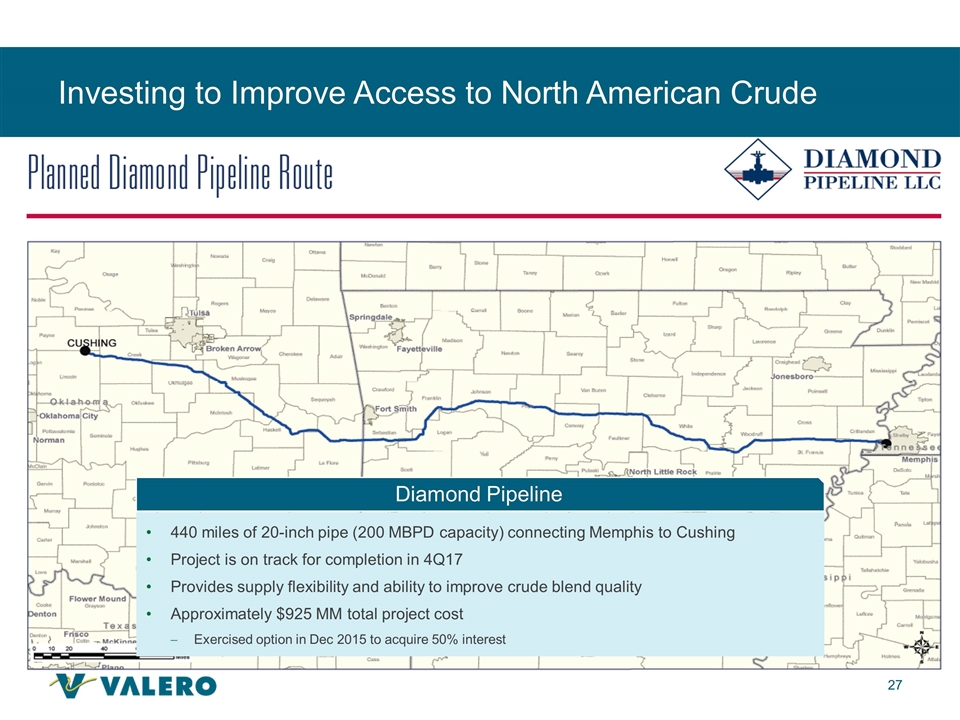
Investing to Improve Access to North American Crude Diamond Pipeline 440 miles of 20-inch pipe (200 MBPD capacity) connecting Memphis to Cushing Project is on track for completion in 4Q17 Provides supply flexibility and ability to improve crude blend quality Approximately $925 MM total project cost Exercised option in Dec 2015 to acquire 50% interest
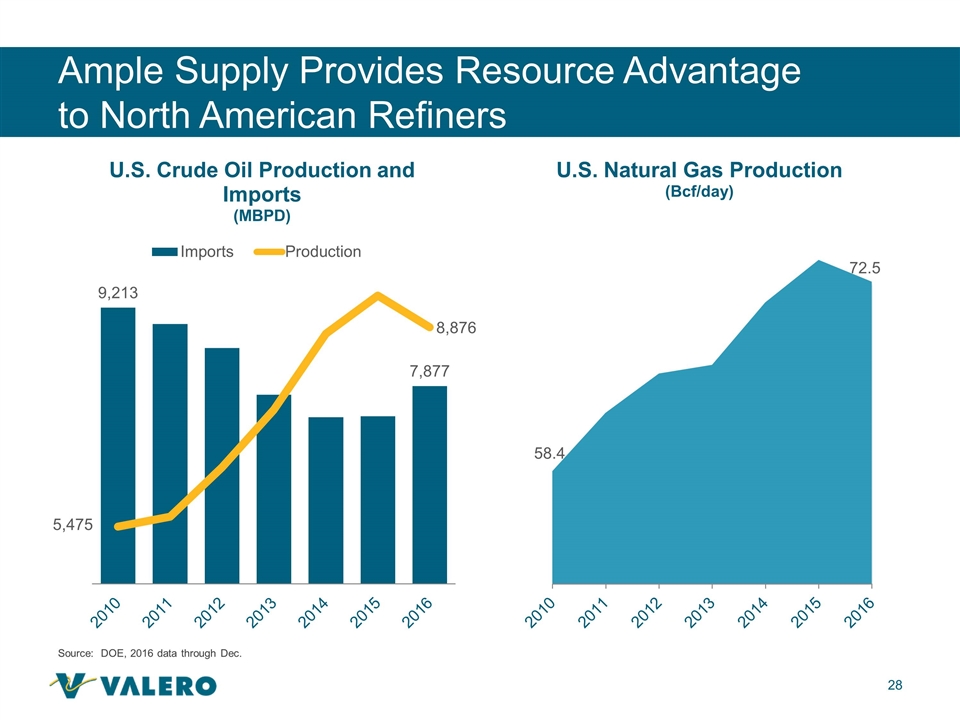
Ample Supply Provides Resource Advantage to North American Refiners Source: DOE, 2016 data through Dec.
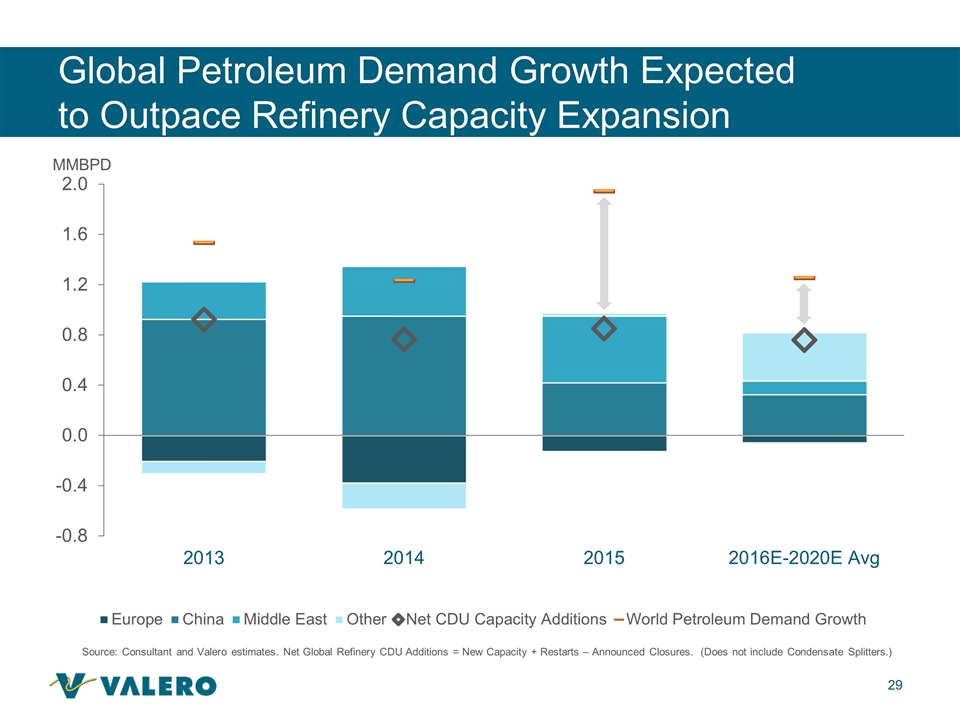
Source: Consultant and Valero estimates. Net Global Refinery CDU Additions = New Capacity + Restarts – Announced Closures. (Does not include Condensate Splitters.) Global Petroleum Demand Growth Expected to Outpace Refinery Capacity Expansion
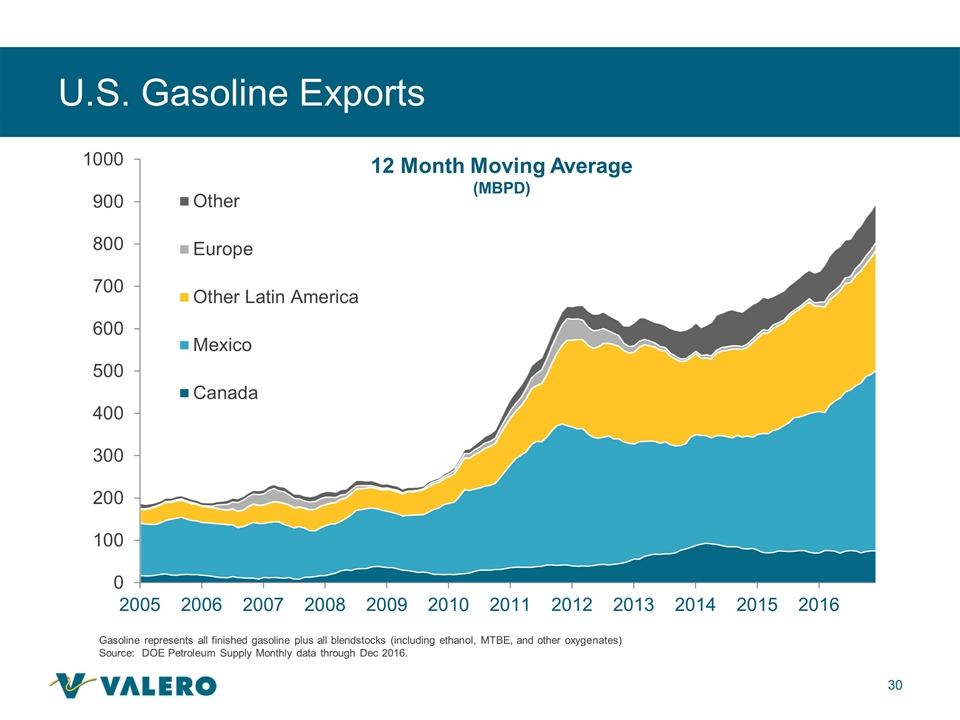
Gasoline represents all finished gasoline plus all blendstocks (including ethanol, MTBE, and other oxygenates) Source: DOE Petroleum Supply Monthly data through Dec 2016. U.S. Gasoline Exports
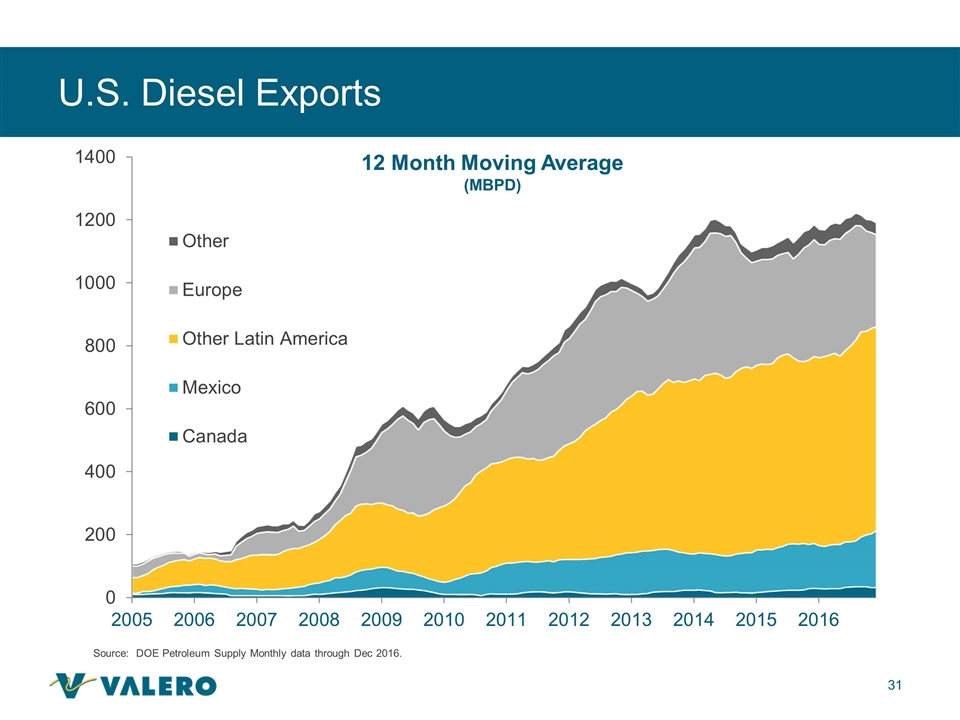
Source: DOE Petroleum Supply Monthly data through Dec 2016. U.S. Diesel Exports 12 Month Moving Average (MBPD)
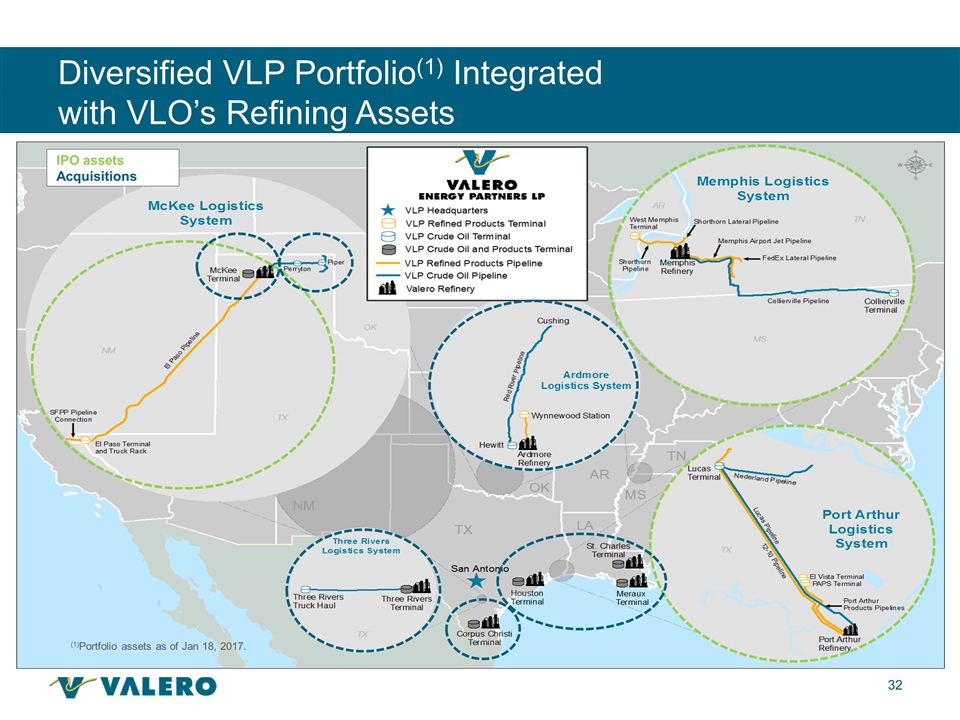
Diversified VLP Portfolio(1) Integrated with VLO’s Refining Assets IPO assets Acquisitions (1)Portfolio assets as of Jan 18, 2017.
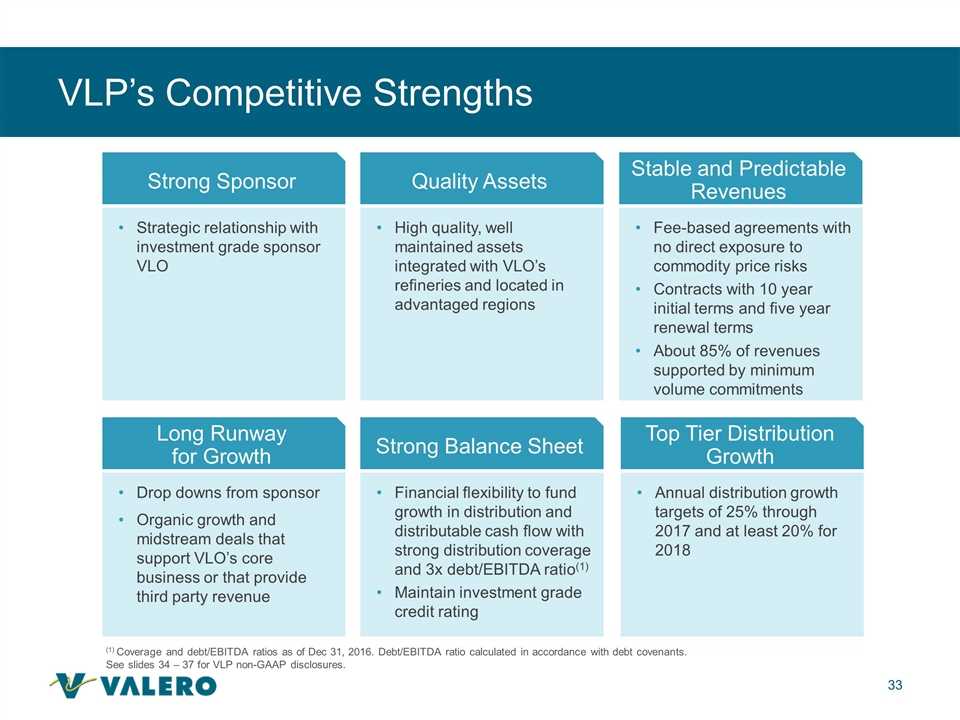
VLP’s Competitive Strengths Strong Sponsor Strategic relationship with investment grade sponsor VLO Quality Assets High quality, well maintained assets integrated with VLO’s refineries and located in advantaged regions Stable and Predictable Revenues Fee-based agreements with no direct exposure to commodity price risks Contracts with 10 year initial terms and five year renewal terms About 85% of revenues supported by minimum volume commitments Strong Balance Sheet Financial flexibility to fund growth in distribution and distributable cash flow with strong distribution coverage and 3x debt/EBITDA ratio(1) Maintain investment grade credit rating Long Runway for Growth Drop downs from sponsor Organic growth and midstream deals that support VLO’s core business or that provide third party revenue Top Tier Distribution Growth Annual distribution growth targets of 25% through 2017 and at least 20% for 2018 (1) Coverage and debt/EBITDA ratios as of Dec 31, 2016. Debt/EBITDA ratio calculated in accordance with debt covenants. See slides 34 – 37 for VLP non-GAAP disclosures.
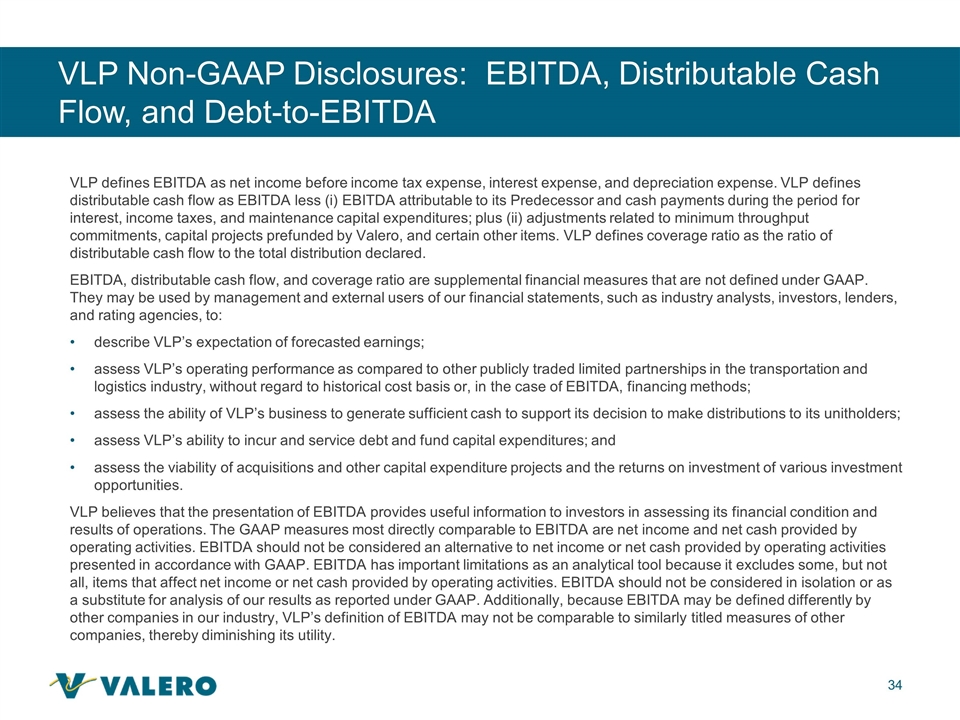
VLP Non-GAAP Disclosures: EBITDA, Distributable Cash Flow, and Debt-to-EBITDA VLP defines EBITDA as net income before income tax expense, interest expense, and depreciation expense. VLP defines distributable cash flow as EBITDA less (i) EBITDA attributable to its Predecessor and cash payments during the period for interest, income taxes, and maintenance capital expenditures; plus (ii) adjustments related to minimum throughput commitments, capital projects prefunded by Valero, and certain other items. VLP defines coverage ratio as the ratio of distributable cash flow to the total distribution declared. EBITDA, distributable cash flow, and coverage ratio are supplemental financial measures that are not defined under GAAP. They may be used by management and external users of our financial statements, such as industry analysts, investors, lenders, and rating agencies, to: describe VLP’s expectation of forecasted earnings; assess VLP’s operating performance as compared to other publicly traded limited partnerships in the transportation and logistics industry, without regard to historical cost basis or, in the case of EBITDA, financing methods; assess the ability of VLP’s business to generate sufficient cash to support its decision to make distributions to its unitholders; assess VLP’s ability to incur and service debt and fund capital expenditures; and assess the viability of acquisitions and other capital expenditure projects and the returns on investment of various investment opportunities. VLP believes that the presentation of EBITDA provides useful information to investors in assessing its financial condition and results of operations. The GAAP measures most directly comparable to EBITDA are net income and net cash provided by operating activities. EBITDA should not be considered an alternative to net income or net cash provided by operating activities presented in accordance with GAAP. EBITDA has important limitations as an analytical tool because it excludes some, but not all, items that affect net income or net cash provided by operating activities. EBITDA should not be considered in isolation or as a substitute for analysis of our results as reported under GAAP. Additionally, because EBITDA may be defined differently by other companies in our industry, VLP’s definition of EBITDA may not be comparable to similarly titled measures of other companies, thereby diminishing its utility.
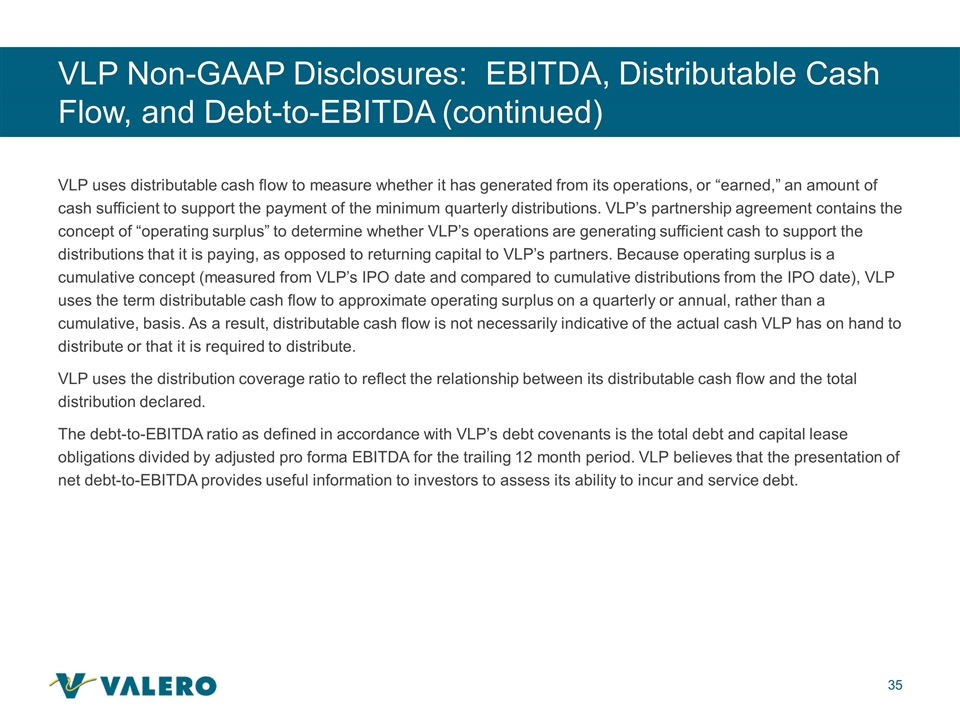
VLP Non-GAAP Disclosures: EBITDA, Distributable Cash Flow, and Debt-to-EBITDA (continued) VLP uses distributable cash flow to measure whether it has generated from its operations, or “earned,” an amount of cash sufficient to support the payment of the minimum quarterly distributions. VLP’s partnership agreement contains the concept of “operating surplus” to determine whether VLP’s operations are generating sufficient cash to support the distributions that it is paying, as opposed to returning capital to VLP’s partners. Because operating surplus is a cumulative concept (measured from VLP’s IPO date and compared to cumulative distributions from the IPO date), VLP uses the term distributable cash flow to approximate operating surplus on a quarterly or annual, rather than a cumulative, basis. As a result, distributable cash flow is not necessarily indicative of the actual cash VLP has on hand to distribute or that it is required to distribute. VLP uses the distribution coverage ratio to reflect the relationship between its distributable cash flow and the total distribution declared. The debt-to-EBITDA ratio as defined in accordance with VLP’s debt covenants is the total debt and capital lease obligations divided by adjusted pro forma EBITDA for the trailing 12 month period. VLP believes that the presentation of net debt-to-EBITDA provides useful information to investors to assess its ability to incur and service debt.
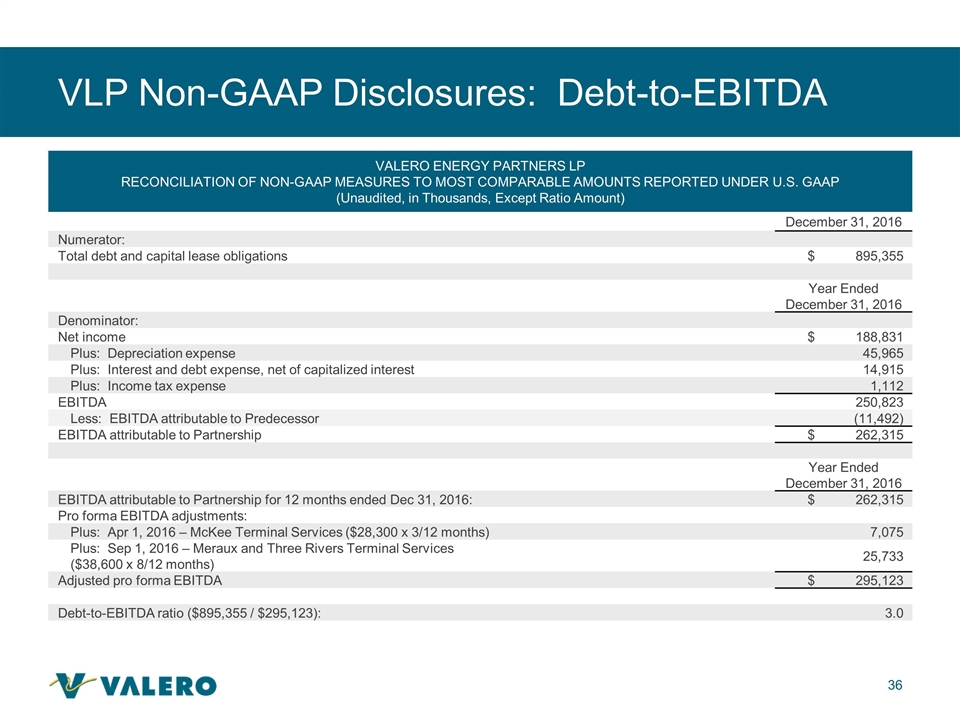
VLP Non-GAAP Disclosures: Debt-to-EBITDA VALERO ENERGY PARTNERS LP RECONCILIATION OF NON-GAAP MEASURES TO MOST COMPARABLE AMOUNTS REPORTED UNDER U.S. GAAP (Unaudited, in Thousands, Except Ratio Amount) December 31, 2016 Numerator: Total debt and capital lease obligations $ 895,355 Year Ended December 31, 2016 Denominator: Net income $188,831 Plus: Depreciation expense 45,965 Plus: Interest and debt expense, net of capitalized interest 14,915 Plus: Income tax expense 1,112 EBITDA 250,823 Less: EBITDA attributable to Predecessor (11,492) EBITDA attributable to Partnership $262,315 Year Ended December 31, 2016 EBITDA attributable to Partnership for 12 months ended Dec 31, 2016: $262,315 Pro forma EBITDA adjustments: Plus: Apr 1, 2016 – McKee Terminal Services ($28,300 x 3/12 months) 7,075 Plus: Sep 1, 2016 – Meraux and Three Rivers Terminal Services ($38,600 x 8/12 months) 25,733 Adjusted pro forma EBITDA $295,123 Debt-to-EBITDA ratio ($895,355 / $295,123): 3.0
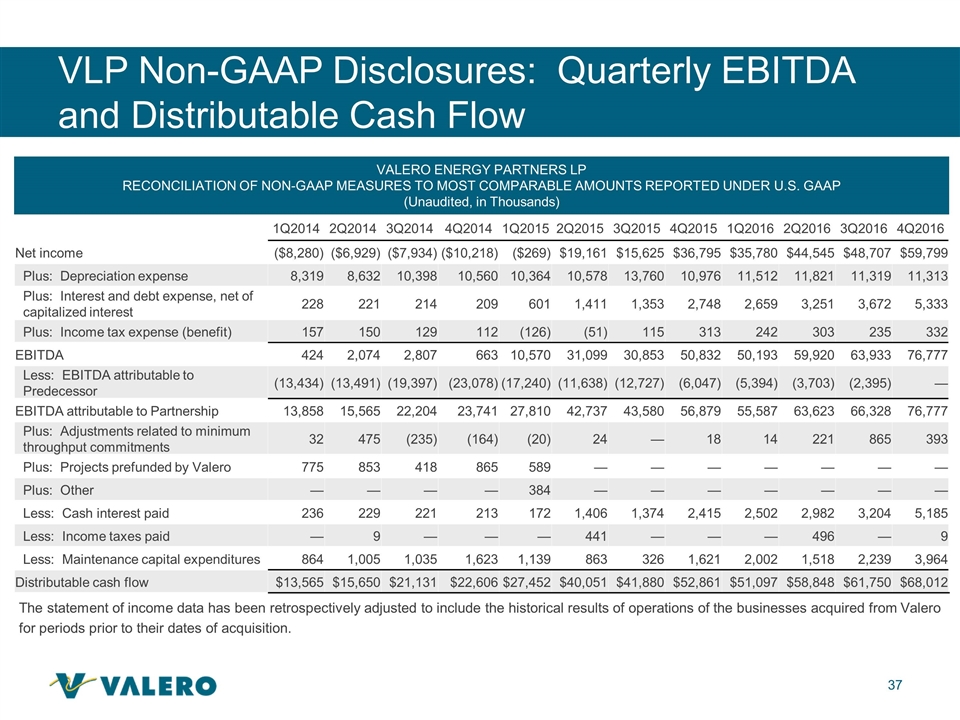
1Q2014 2Q2014 3Q2014 4Q2014 1Q2015 2Q2015 3Q2015 4Q2015 1Q2016 2Q2016 3Q2016 4Q2016 Net income ($8,280) ($6,929) ($7,934) ($10,218) ($269) $19,161 $15,625 $36,795 $35,780 $44,545 $48,707 $59,799 Plus: Depreciation expense 8,319 8,632 10,398 10,560 10,364 10,578 13,760 10,976 11,512 11,821 11,319 11,313 Plus: Interest and debt expense, net of capitalized interest 228 221 214 209 601 1,411 1,353 2,748 2,659 3,251 3,672 5,333 Plus: Income tax expense (benefit) 157 150 129 112 (126) (51) 115 313 242 303 235 332 EBITDA 424 2,074 2,807 663 10,570 31,099 30,853 50,832 50,193 59,920 63,933 76,777 Less: EBITDA attributable to Predecessor (13,434) (13,491) (19,397) (23,078) (17,240) (11,638) (12,727) (6,047) (5,394) (3,703) (2,395) — EBITDA attributable to Partnership 13,858 15,565 22,204 23,741 27,810 42,737 43,580 56,879 55,587 63,623 66,328 76,777 Plus: Adjustments related to minimum throughput commitments 32 475 (235) (164) (20) 24 — 18 14 221 865 393 Plus: Projects prefunded by Valero 775 853 418 865 589 — — — — — — — Plus: Other — — — — 384 — — — — — — — Less: Cash interest paid 236 229 221 213 172 1,406 1,374 2,415 2,502 2,982 3,204 5,185 Less: Income taxes paid — 9 — — — 441 — — — 496 — 9 Less: Maintenance capital expenditures 864 1,005 1,035 1,623 1,139 863 326 1,621 2,002 1,518 2,239 3,964 Distributable cash flow $13,565 $15,650 $21,131 $22,606 $27,452 $40,051 $41,880 $52,861 $51,097 $58,848 $61,750 $68,012 VLP Non-GAAP Disclosures: Quarterly EBITDA and Distributable Cash Flow VALERO ENERGY PARTNERS LP RECONCILIATION OF NON-GAAP MEASURES TO MOST COMPARABLE AMOUNTS REPORTED UNDER U.S. GAAP (Unaudited, in Thousands) The statement of income data has been retrospectively adjusted to include the historical results of operations of the businesses acquired from Valero for periods prior to their dates of acquisition.
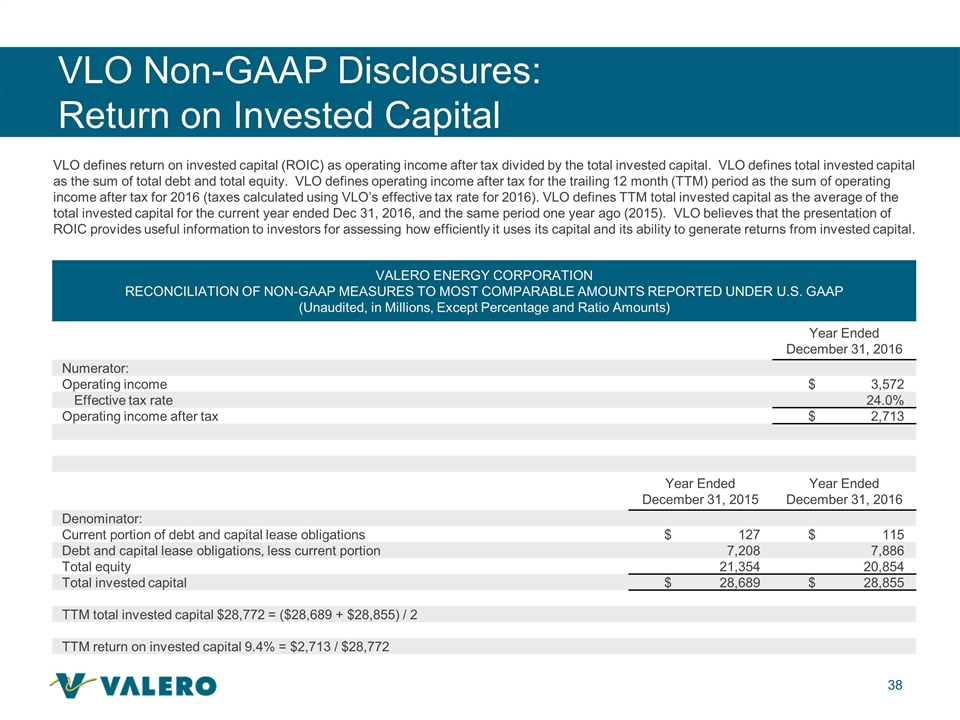
VLO Non-GAAP Disclosures: Return on Invested Capital VALERO ENERGY CORPORATION RECONCILIATION OF NON-GAAP MEASURES TO MOST COMPARABLE AMOUNTS REPORTED UNDER U.S. GAAP (Unaudited, in Millions, Except Percentage and Ratio Amounts) Year Ended December 31, 2016 Numerator: Operating income $ 3,572 Effective tax rate 24.0% Operating income after tax $2,713 Year Ended December 31, 2015 Year Ended December 31, 2016 Denominator: Current portion of debt and capital lease obligations $ 127 $ 115 Debt and capital lease obligations, less current portion 7,208 7,886 Total equity 21,354 20,854 Total invested capital $28,689 $28,855 TTM total invested capital $28,772 = ($28,689 + $28,855) / 2 TTM return on invested capital 9.4% = $2,713 / $28,772 VLO defines return on invested capital (ROIC) as operating income after tax divided by the total invested capital. VLO defines total invested capital as the sum of total debt and total equity. VLO defines operating income after tax for the trailing 12 month (TTM) period as the sum of operating income after tax for 2016 (taxes calculated using VLO’s effective tax rate for 2016). VLO defines TTM total invested capital as the average of the total invested capital for the current year ended Dec 31, 2016, and the same period one year ago (2015). VLO believes that the presentation of ROIC provides useful information to investors for assessing how efficiently it uses its capital and its ability to generate returns from invested capital.
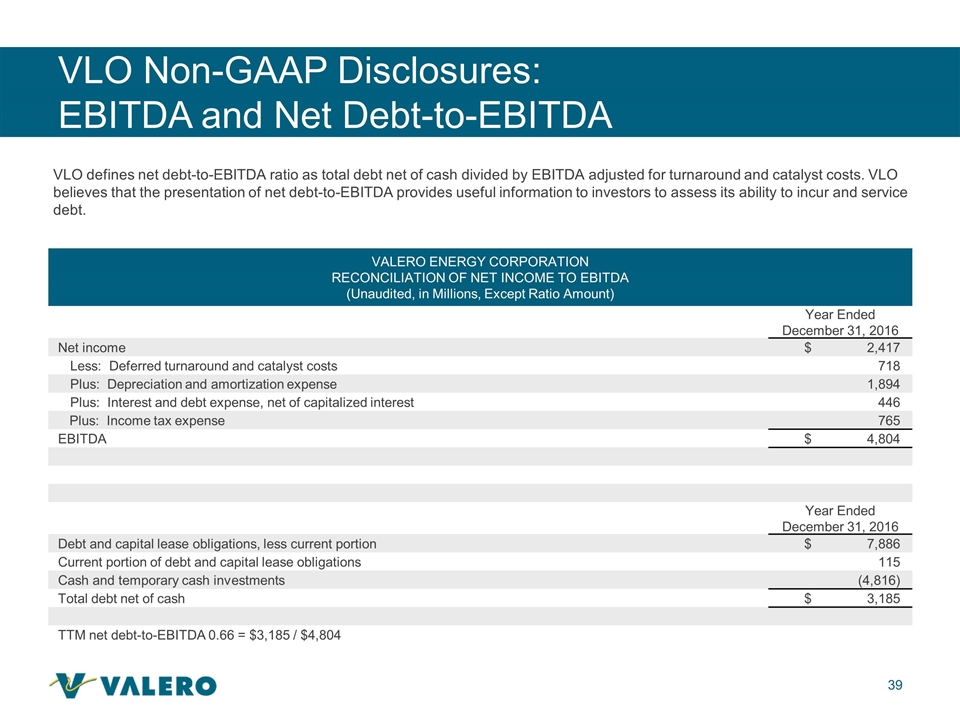
VLO Non-GAAP Disclosures: EBITDA and Net Debt-to-EBITDA VALERO ENERGY CORPORATION RECONCILIATION OF NET INCOME TO EBITDA (Unaudited, in Millions, Except Ratio Amount) Year Ended December 31, 2016 Net income $ 2,417 Less: Deferred turnaround and catalyst costs 718 Plus: Depreciation and amortization expense 1,894 Plus: Interest and debt expense, net of capitalized interest 446 Plus: Income tax expense 765 EBITDA $4,804 Year Ended December 31, 2016 Debt and capital lease obligations, less current portion $ 7,886 Current portion of debt and capital lease obligations 115 Cash and temporary cash investments (4,816) Total debt net of cash $3,185 TTM net debt-to-EBITDA 0.66 = $3,185 / $4,804 VLO defines net debt-to-EBITDA ratio as total debt net of cash divided by EBITDA adjusted for turnaround and catalyst costs. VLO believes that the presentation of net debt-to-EBITDA provides useful information to investors to assess its ability to incur and service debt.
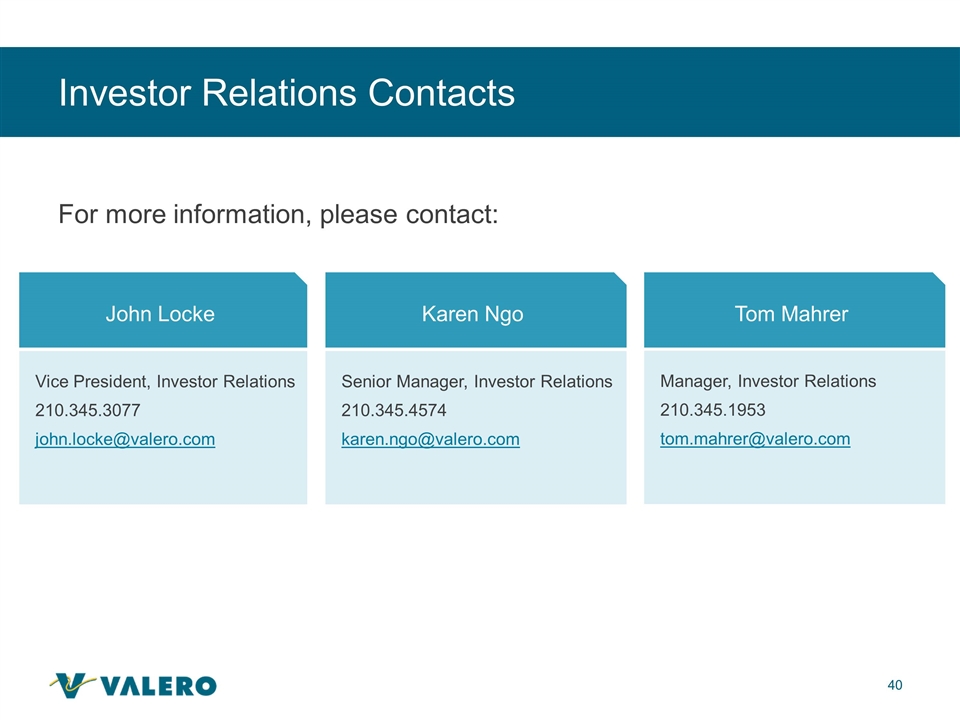
Investor Relations Contacts For more information, please contact: John Locke Vice President, Investor Relations 210.345.3077 [email protected] Karen Ngo Senior Manager, Investor Relations 210.345.4574 [email protected] Tom Mahrer Manager, Investor Relations 210.345.1953 [email protected]
Serious News for Serious Traders! Try StreetInsider.com Premium Free!
You May Also Be Interested In
- Valero Energy (VLO) Tops Q1 EPS by 62c
- Valero Energy (VLO) PT Raised to $192 at Citi
- Valero Energy (VLO) April weekly option implied volatilit into quarter results
Create E-mail Alert Related Categories
SEC FilingsSign up for StreetInsider Free!
Receive full access to all new and archived articles, unlimited portfolio tracking, e-mail alerts, custom newswires and RSS feeds - and more!



 Tweet
Tweet Share
Share